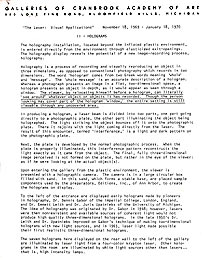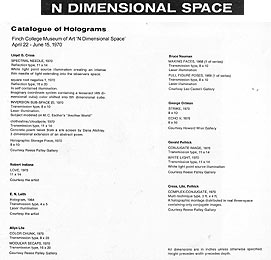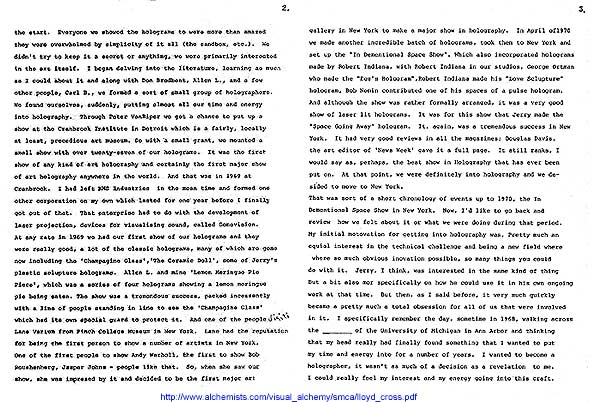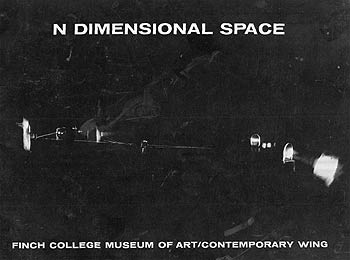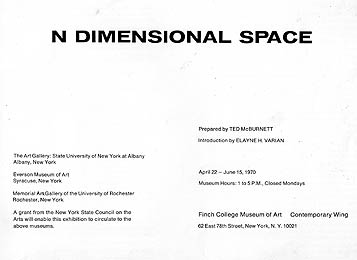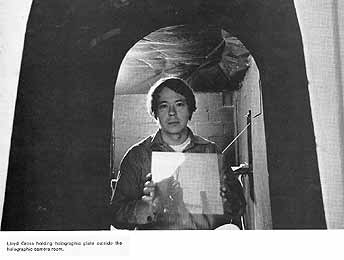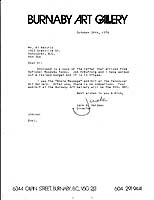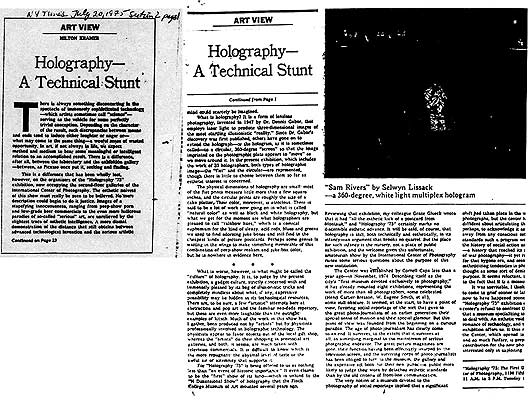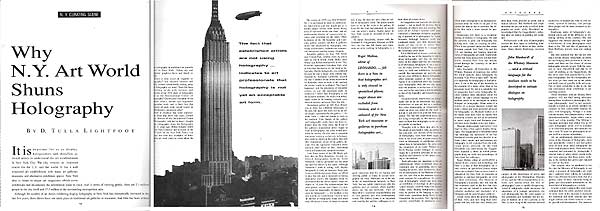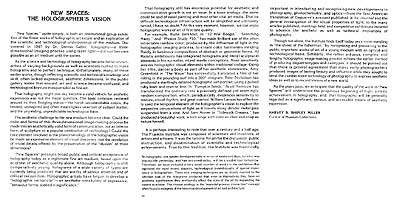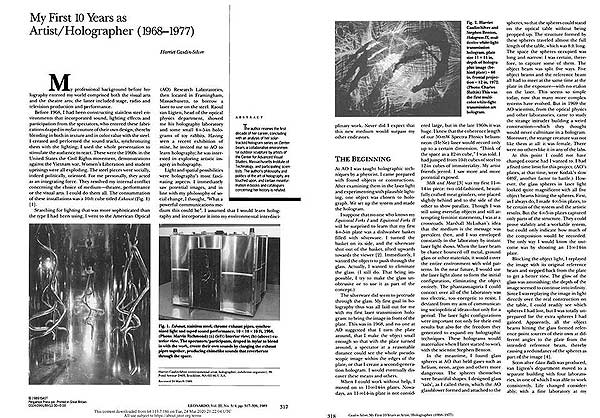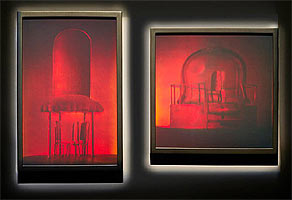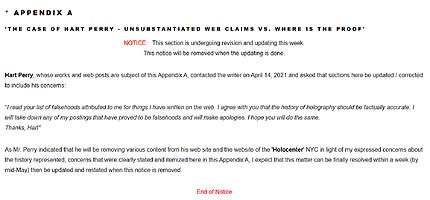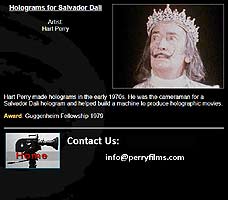Art and Holography - Part 3
Al Razutis 2020
2020 Essay by Al Razutis on the origins and usage of the term holographic art, or art holography, as it was represented in the early period (the 1970's) in North America by various authors whose contributions are examined one by one. Its current resting place is analyzed from the standpoint of this last decade in New York and Los Angeles, and a small island off the west coast of Canada where some illuminated texts reside.
LINKS TO MAIN TOPICS -- Numbered with decimals system

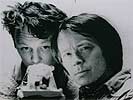
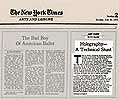

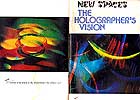
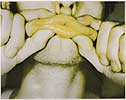
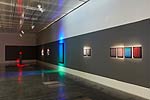
Introduction
First Holo Exhibition
NYC 1975 Exhibition
What is 'visual alchemy'?
1979 Franklin Exhibition
Nauman & artists in Holo
Moon 2012 Exhibition
This is the third part of the the following series: Art and Holography 1 (1985) Art and Holography 2 (1985)
This essay concludes with a re-evaluation of the aesthetic and cultural principles which governed this evolution of holographic art, especially as it pertains to today's media culture and near-absence of this art form from the fine arts and their institutions.
Of relevant interest: 'How Much for that Holo?' -- 2020 essay by Al Razutis
Even more relevant is how this ended: 'Holo Vanities' and 'West-Coast Artists in Light' -- 2022 essay by Al Razutis
Of very relevant interest to our topics, not covered here but elsewhere:
'3D or not 3d? Dalinian Stereo and Holographic Space'

Art and Holography #3
"Holography was not created or initially envisioned as art" (AR)
But that would come later and so this story is told
3.0.0 Introduction
When 'holography' was invented by Dr. Dennis Gabor in the 1940's it wasn't invented as "art". Simply put, this was not a 'art theory' (nor art practice) but an invention to 'improve on the resolution of the electron microsocope'. So, where did the idea of 'holographic art' come from? Bear with me, you'll see.
The first bit of the puzzle is to understand 'what is holography', and for that I refer us to Dennis Gabor's 1971 Nobel Lecture (he received the Nobel Prize for Physics that year for this invention). A copy of this lecture is available at http://www.alchemists.com/fb/gabor-lecture.pdf.
Dr. Dennis Gabor pictured with blackboard diagram of laser transmission hologram recording process.

NOTES and FAQ:
"Who' claimed that they 'made the Dali holograms', without having to prove it? For such examples visit Appendix A, the subject being 'who made that Dali!?'.
'Who' keeps claiming on the web that 'it was Gabriel Lippman who invented holography at the turn of the last century' (not Dennis Gabor in the 1940's, for which Gabor received a Nobel Prize in the 1970's)? Who? The answer is documented here as a guy in NYC named "Doctor Laser!", real name Jason Sapan, who runs a holo shop in NYC, who is not a doctor, but was an actor, who did NOT invent any laser, but wears a lab coat with 'Doctor' written on it. (Run laugh track. In the world of 'holo-groups' this guy is very popular and deserves a note or two for his fans to chew on.) See these claims and others de-mystified in this essay's Appendix B.
NOTE also: There are many loud public holo-personalities (meaning, they reside in the social holo-sphere) who have claimed "everything is art", so that any thing whatsover would qualify in their minds as "art", regardless of its intention. This 'everything is everything theory' is avoided like the plague here, as are its proponents, many of whom have found a roost on 'holo face book'. It seems to be a persistent breed of nonsense that plagues all civilizations, and to note it is to wish it to go away.
Lastlly, 'who are the personalities' who have contributed to the re-writing of Canadian holography history and the erasure of this author's work (the author of this essay) within this history? Who? Check it all out, it starts with a visit to a gallery, like returning 'home', like in a 'Greek Odysey'. This tale is in Appendix C, the final one to this essay.
3.0.1 A necessary reminder:
Before there was 'holo art' there was science...
-- this section requoted from the essay 'How Much For That Holo?' by Al Razutis 2020 / 2021.
We'll call this the 'old testament', because it largely pertains to the 1960's and 70's when holography itself was the discovery and focus of interest, and promises were made but sometimes not kept.
When Emmett Leith and Juris Upatnieks wanted to demonstrate what holography could do in 1962 - 64, now that the laser was invented to deliver pure near single wavelength light, they showed off a toy train imaged in a off-axis transmission hologram, their invention, independent of the train.
When scientists engineers wanted to show off a theory and its practical applications they usually picked any object they liked to make a holographic image of. Sometimes they invited artists 'to collaborate', like Conductron Corp. did in the 60's with Bruce Nauman.
But usually 'display holography', as it came to be called, was there to display holography, its principles, its capabilities. It was considered inferior to 'art holography' only by the academics or aesthetes and particularly in valuation and price in which 'art holograms' commanded much more money. This split between 'art' and 'display' is the split between arts and crafts going back eons, and perhaps is also reflected between philosophies of the 'ideal' and the 'practical' in culture.
Direct testimonials from Emmett Leith and Juris Upatnieks, separately, and from vastly different medias and interpretations by those quoting them:
Emmett Leith on the creation of first off-axis holograms (PDF download)
Juris Upatneiks on the creation of first off-axis holograms (YOUTUBE video by Al Razutis / XAR3D )
3.1.0 What does it mean to be the 'first show of holograms in a Art Gallery'?
"It's time to understand how it became art, but only as a mater of assertion, later convenience not essence, because frankly the patrons were scarce." (AR).
This is the way the history of holography and art reads, as if etched in stone, with details lost, therefore to be invented by some:

"The first holographic art exhibition was held at the Cranbrook Academy of Art in Michigan in 1968.
The second took place at the Finch College gallery in New York in 1970 and attracted national media attention."
- S. Johnston, Holographic Visions
'We have to hire an artist! -- C. Charnetski, Conductron Corp. 1969 ('Holographic Visions' S. Johnston)
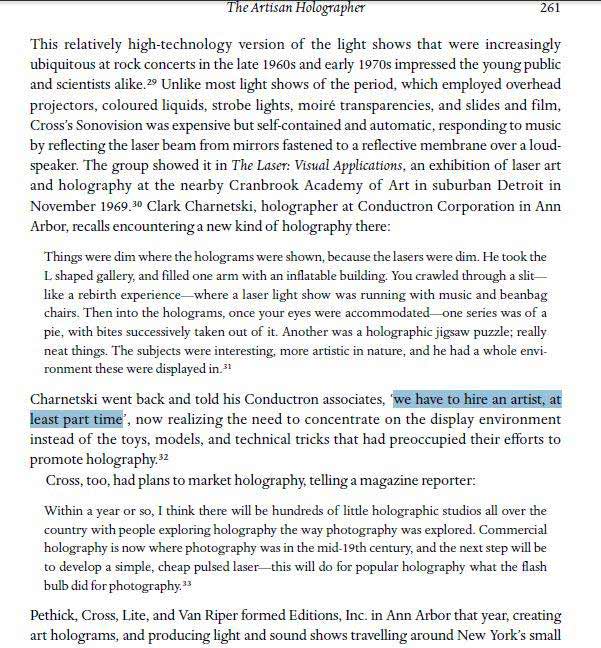
'Art and holography?'
"Nobody heard about it back then, back when, talking 1968 and hippies. It was that new - the laser had only been invented in 1960 and by the time we got to laser viewable transmission holograms were were headed to the end of the 60's and underground films were big in the counter-culture... which is where a trio of extremely talented guys were headed with their lasers, their holography, their light shows.
"So I'm going to pick through the ruins at my leisure and with my own interests guiding me, as is my right as historian, sleuth, and preservationist - critic." -- (AR) Mar 17, 2020, 2:07 PM
3.1.1. The Second Show 'N-Dimensional Spaces'(1970)
The "first show"(Cranbrook Academy of Art Gallery 1968) of holographic art was done by the same guys who did the much more ambitious "second show" of holographic and laser art in 1970 at Finch College Museum of Art, which was called 'N Dimensional Space' for the historical record.
"So, I trace the initial trajectory of the term 'holographic art' or 'art of holography' to these guys, Lloyd Cross and Jerry Pethick, and Allyn Z. Lite, President, EDITIONS Inc. and their 1969 "Finch" exhibition proposal." (A.R.)
Photo of Jerry Pethick (left) and Lloyd Cross (right) - circa 1970 - photographer unknown - collection of Margaret Pethick.

Cover sheet for "HOLOGRAMS AND LASERS, An Experimental Exhibition Exploring Techniques and Application of Modern Optical Technology as Art Media" - prepared by Editions Inc., Ann Arbor, Michigan. Date is circa 1969. Authors: Lloyd Cross, Allyn Z. Lite, President, Jerry Pethick
Introduction, from the Editions Inc. 1969 proposal for exhibition at the Finch College Museum of Art, NYC: "The purpose of this exhibition is to explore the potentials for using advanced laser and optics technology as art media" in which "holography" figures prominently to "fulfill a much needed education as well as aesthetic purpose for a public intensely interested in modern technology and it's applications to art media".
Two part proposal for exhibition - a summary - for the Contemporary Wing of the Finch College Museum of Art. "The first part would be an instructional display in the lower galleries of Finch College Museum and the second part, an exhibition of holograms and laser pieces as art media."
Details of the 1969 proposed exhibition for Finch College Museum of Art by Editions Inc. (Cross, Lite, Pethick) which contains the following 10 items, or as the proposal declared: "This exhibition will include holograms and assorted laser pieces presented as art media and will be as follows:"
- Approximately 20 holograms (8" by 10" and larger). These holograms will explore virtually all holographic techniques, ranging from projected real images of objects floating in space, to the creation of surrealistic landscapes extending to infinity. The plans also include multiple image holograms, in which the subject changes according to the spectator's angle of view; holograms of scenes or objects which could not be constructed in reality but can only exist in a three dimensional holographic reality; holograms of pure spectral color existing in depth.
- A holographic jig-saw puzzle for interaction with the viewers.
- A four-color laser sound piece composed of a 500 milliwatt krypton laser, modulated beam projected onto the inside of a frosted dome and totally coordinated with taped and environmental sound.
- A pulsed infrared laser and KDP crystal which will produce a pure green light beam without apparent source generated through a system of folding mirrors.
- A 10 milliwatt helium neon laser projected onto a monitored screen with photocell and optical scanner. This interactive piece produces a stationary pattern operating in a complex but predictable manner.
- An environmentally reactive laser piece consisting of a 3 milliwatt helium neon laser and front projection screen. This piece uses optical feedback and environmental sound to generate self-controlled patterns.
- A laser "sparkle" chamber which will consist, of a portion of a 500 milliwatt krypton laser beam, completely enclosed in a plexiglas box containing scattering particles.
- A laser skylight which will involve a 3 milliwatt helium neon laser and plastic spatial structure.
- A 3 milliwatt helium neon laser and acrylic tube filled with liquids of varying viscosity. The surfaces of bubbles are used as lenses to diffract the laser beam.
- A portion of a four-color krypton laser will be used to generate lumia-type patterns exploring specific and particular properties of a laser beam."
------------------
What does Lloyd Cross remember of this experience?
The following two pages from Lloyd Cross "Story of Multiplex" provide his and the artists' view of the exhibitions (Cranbrook 1968-9, Finch 1970). and galleries and people. Some notes only.
Download / view entire doc at http://www.alchemists.com/visual_alchemy/smca/lloyd_cross.pdf (pgs 2-3)
-------------
Some added details provided by A. Razutis March 2020 on Face Book:
" While examining the Sharon McCormack Archives at my studio Visual Alchemy in 2020 I discovered an "art show proposal" from Lloyd Cross, Jerry Pethic, Allyn Lite, and dated before 1970. It was titled "HOLOGRAMS AND LASERS - An Experimental Exhibition Exploring Techniques and Applications of Modern Optical Technology as Art Media" from an group calling itself EDITIONS INC. (Ann Arbor, Michigan).
This proposal is to be pitched to the Contemporary Wing of FINCH COLLEGE MUSEUM OF ART in New York City, and this show actually happened in 1970, though it is unclear if it was the same show as proposed since some of these items are never mentioned in the critical revue of the show (also posted along with the other documents to complete the picture).
----------------------
What's interesting here is (quoted from the application) "The purpose of this exhibition is to explore the potentials for using advanced laser and optics technology as art media" in which "holography" figures prominently to "fulfill a much needed education as well as aesthetic purpose for a public intensely interested in modern technology and it's applications to art media".
-----------------
In other words the FOCUS is on "TECHNOLOGY" (as an 'art media') and what that really means is ultimately unclear. This application is scanned, and dowloadable from my web site at: http://www.alchemists.com/visual_alchemy/smca/finch_proposal.pdf
At that point, nobody knew 'what art form holography could take on' and this was one of the beginnings (joining Bruce Nauman's shows of his holograms making faces, or Margaret Benyon or Harriet Casden Silver beginning to exhibit and experiment with 'art' and what that really means, and tentative at best it all was...
There was no 'mature' art scene concerning holography of the art of it in 1970... each one was on his own.
This proposal was most certainly authored and guided by Dr. Lloyd Cross, a laser physicist and previous project manager at Willow Run labs who decided to 'drop out' and 'do art'. And this is key to understanding the direction future art shows would take.
-------------------------------------
... This proposal for 'holographic art' presents an exhibition concept that includes laser light shows, sculpture, labyrinth, in other words, a "multimedia" and "intermedia" exhibition what was indeed in keeping with those times (think: Experiments in Art and Technology (EAT) in NYC, think Intermedia in Vancouver Canada).
Think Youngblood's "Expanded Cinema" book, 1970 a copy of which in pdf is downloadable from my web site:
http://www.alchemists.com/fb/expanded_cinema_youngblood.pdf
What does "Expanded Cinema" (Youngblood, 1970) have to do with holography and holographic art in the 1970's? And works done at Visual Alchemy? Everything.
Here is my web page on it. http://www.alchemists.com/visual_alchemy/intermedia-holo.html
Mar 19, 2020, 1:22 PM
-------------------------------------
In 2023 while examining the Sharon McCormack Collection and Archives further we discovered the 'N Dimensional Space' -- Finch College Museum of Art 1970 Catalog' in which there are the following pages showing some details, in particular the 'art works by Lloyd Cross' listed. Click Thumbnails for enlarged views in separate windows.
-------------------------------
But Not all ended well or on a upbeat for Editions, Inc.

Every 'up' can have its 'down', certainly in analog holography, laser physics, interference and coherence, and exhibitions about it... And certainly if you're going to exhibit it as "ART" in NYC the Big Apple.
So the down for the exhibiting holographers in 1970, the show at the Finch Museum titled "N-Dimensional Space", was the revue by the New York Times art critic who titled it "Art: Holograms in their Infancy", and man did that one 'hurt'. This wouldn't be the last time either.
A downloadable PDF of this revue is on my website at: http://www.alchemists.com/visual_alchemy/smca/editions-1970nytimes-revue.pdf.
If I'm going to talk media archaeology here, and of the first US "holographic art" shows, then I should tell you more than just the names of those 'art and holo science pioneers' who did them.
Meet the makers: Dr. Lloyd Cross, Allyn Z. Lite (President), Jerry Pethick with their bios up to 1970, already impressive they were. The three bios, written by these individuals accompanied this proposal for a Finch Museum exhibition in NYC in 1970. They also did the "first one" in 1968 at the Cranbrook Academy of Art in Michigan. And with these two exhibitions they made history!
Under the name of "Editions, Inc." (of Ann Arbor, Michigan) in the years are 1968-1970 the birth of holography and laser displays was celebrated as more than a lab experiment, as something they called "art".
Bio of Lloyd Cross scanned from the Editions Inc. 1969 application to do a exhibition at Finch College NYC the following year. A downloadable pdf of this bio is available from my web site at: http://www.alchemists.com/visual_alchemy/smca/editions-cross.pdf
Bio of Allyn Lite scanned from the Editions Inc. 1969 application to do a exhibition at Finch College NYC the following year. A downloadable pdf of this bio is available from my web site at: http://www.alchemists.com/visual_alchemy/smca/editions-lite.pdf
Bio of Jerry Pethick scanned from the Editions Inc. 1969 application to do a exhibition at Finch College NYC the following year. A downloadable pdf of this bio is available from my web site at: http://www.alchemists.com/visual_alchemy/smca/editions-pethick.pdf
------------- Page Top -------------
3.2.0 The Show of the 'First Decade!' - NYC 1975
"My invitation to participate in this show "Holography 1975 - The first Decade" came in the form of a telegram from curator organizer Jody Burns. Of course I was honoured to be invited to the big dance in the big apple! Of course I was busy preparing my own inaugural holographic art show funded by Canada governments. Of course I had to decline, but not out of animosity or aloofness but out of focus and loyalty to my Canadian Council and Museum art sponsors, and out of respect and loyalty to the Burnaby Art Gallery." (AR)
I describe 'the choice' of where to show first in a previous Face Book as follows:
"I had to decline for no other reason that I had been delaying ANY exhibition of my holographic works (begun in 1972 with all kinds of experimentation in my Vancouver studio) until the day when my own solo holo show 'Visual Alchemy' (for which my studio was named) opened at the Burnaby Art Gallery in 1977 as planned.
"Here are three exhibits, a telegram from Jody Burns in NYC inviting me to their upcoming exhibition, a confirmation from the Director of the Burnaby Art Gallery that all systems were a go and that it will be the "real" thing, and my own panel of images from my own upcoming show, and a link to its pictorial summary." (AR)
More on the Visual Alchemy holo show is at http://www.alchemists.com/visual_alchemy/holo_visual.html#visual
What the inventor of holography Dr. Dennis Gabor thought when seeing a multiplex hologram for the first time at the 1973 Medical Applications Show in NYC:
|
"Dennis Gabor was touring the exhibits, followed everywhere by a large group of acolytes. When he came to the Multiplex he stopped and peered into it (the display was motorized). After a long pause while we held our breath, he said.......... "Marvelous". " -- recollection by Lon Moore, 2021 |
Hilton Kramer, Art Critic for NY Times trashes the show
When NYC holography curators / organizers (for the exhibition "Holography 1975: The First Decade") in the mid 1970's met their New York Times art critic Hilton Kramer - from that point on something went really 'bad':
"It is, to judge by the present exhibition, a gadget culture, strictly concerned with and immensely pleased by its bag of illusionistic tricks and completely mindless about what, if any, expressive possibilities may lie hidden in its technological resources. There are, to be sure, a few artistic attempts here at abstraction and pop art and the familiar neo-dada repertory, but these are even more laughable than the outright examples of kitsch. Much of the work has, I gather, been produced not by artists but by physicists professionally involved in holographic technology. The physicists appear to favor objects out of the local gift shop, whereas the artists do their shopping in provincial art galleries, and both, it seems, are much taken with television commercials. It is difficult to know which is the more repugnant: the abysmal level of taste or the awful air of solemnity that supports it." (Hilton Kramer)
Download Kramer NY Times article in PDF from my web site at http://www.alchemists.com/fb/kramer_nytimes_jul20-1975.pdf
Mar 21, 2020, 12:56 PM
----------------------------------
Harriet Casdin-Silver, a participating artist trashes the show
It wasn't just Hilton Kramer who ripped into the 1975 holography show in NYC for its form and lack of content, but also one of the participating artists, Harriet Casdin-Silver, who wrote:
"I wanted to take my art out of that show [. . .] I thought it stank to high heaven. There was so little real art in it [. . .] But from the holographic artist's point of view, the art critics stood in the doorway, looked in and really saw nothing [. . .] I never saw them at my installation. The show should not have happened, it was too early on. Typical people who had six weeks of holography called themselves artists."
Mar 21, 2020, 1:36 PM
----------------------------------
After this, one could wonder "would holography ever recover from this?"
A decade later, 1987 to be precise, the same problem (lack of critical dialog and theory) for holographic artists and NYC 'art scene' was examined as per this article for Wavefront by D. Tulla Lightfoot: 'Why New York Art World Shuns Holography' (html page).
------------- Page Top -------------
3.3.0 Another Show of the Decade - Franklin Institute 1979-1980
The next large public exhibition of "holographic art" in the 1970's USA was organized for the venerable Franklin Institute in Philadelphia, USA, and ran 1979-80. It was called "New Spaces - The Holographer's Vision".
Introduction and comments by Al Razutis:
"After the unfriendly reception that holographic 'art' received from the art critics in New York City (see "Finch College" 1970 exhibition 'N-Dimensional Space' above, see 'International Center of Photography' exhibition 'Holography 1975: The First Decade' 1975 directly above), I would presume that this exhibition would be organized along more 'curated' lines (less inclusive of 'everything'), and be defended or explained in a multi-page catalog of curator, organizer, and artist statements, which this was.
" And this was Philadelphia, not NYC, and this was the Franklin, not just any museum.
For the record and the context:
" I was part of this Franklin Institute "New Spaces" 1979 exhibition - I had three of my works (from my previous touring 'Visual Alchemy' exhibition) included in this and I contributed a critical essay to the exhibition catalog Some Notes on the Art of Holography.
" My comments on the exhibition or contents came from afar. I never saw the exhibition in person. But I have seen some of the art works in person elsewhere and knew some of the artists personally." (AR)
3.3.1 Curator Shipley Miller's statement
"New Spaces" presages broad public and critical acceptance of holography today as a legitimate fine art medium, based upon the acid-test of aesthetic quality alone. Although holography is still comparatively young. holograms of a wide variety of types are currently being produced that are worthy of serious attention and of critical recognition. Holographic artists have begun to develop a 'holographic vernacular' -- an aesthetic vocabulary of expressive, 'sensuous forms, soaked in significance.' "
-- HARVEY S. SHIPLEY MILLER, Curator of Museum Collections
Mar 22, 2020, 11:08 AM
---------------------
Comments (by Al Razutis) on the Curator Miller's statement and aims - objectives for the show:
"Curator Shipley Miller charts out a bold course and declares the place of these works, this exhibition as an anticipation of the ""...broad public and critical acceptance of holography today as a legitimate fine art medium, based upon the acid-test of aesthetic quality alone. Although holography is still comparatively young, holograms of a wide variety of types are currently being produced that are worthy of serious attention and of critical recognition. Holographic artists have begun to develop a 'holographic vernacular' -- an aesthetic vocabulary of expressive, 'sensuous forms, soaked in significance'. "
"His statement not only reaffirms the role of the Franklin Institute in preserving and exhibiting milestones of scientific inventions and technological achievements, but notes its role in "introducing and recognizing new developments in photography, photochemistry, and optics..."
"He concludes with the following:
"As the years pass, we anticipate that the quality of the work in 'New Spaces" will underscore the propitious beginning of high, artistic achievement in holography: and, that holography will be generally regarded as a significant, serious, and accessible means of aesthetic expression."
--
HARVEY S. SHIPLEY MILLER,
Curator of Museum Collections
------------- Page Top -------------
3.4.0 Franklin Institute Artists - Formalizing what is 'Holographic Art'
Comments (by Al Razutis) identify the nature of the inquiry:
"This March 2020 Face Book post, and the posts immediately flowing from it, contain six essays supported by or elaborated on by other essays, videos, interviews from a number of sources.
"The six essays contained in the Franklin Institute's 'New Spaces' exhibition of 1979 began with the curator Shipley Miller's provocative statement essay.
"In chronological order of catalog presentation the participating artists who provided essays were (with links to their page sections) Anait Arutunoff Stephens, Harriet Casdin-Silver, Rudie Berkhout, Al Razutis, and Amy Greenfield. Their ideas and contribution should be seen in light of the overall show which is represented by the LIST of participating artists, images in black and white in the PDF pages linked below.
Together, one might consider that this exhibition and catalog went a long ways in determining an "art of holography", a "holographic art" that could be explained, shown by example, debated with other art critics and historians." (AR)
A complete list of all the contents and all the works exhibited are posted on my web site at the following two urls (part one and part two of catalog for "New Spaces") - please refer to these pdf pages for a LIST and PHOTOS of EXHIBITING ARTISTS:
http://www.alchemists.com/fb/franklin_new_spaces1.pdf ("New Spaces - The Holographer's Vision" Catalog pages 1-36)
and
http://www.alchemists.com/fb/franklin_new_spaces2.pdf ("New Spaces - The Holographer's Vision" Catalog pages 37-66)
==========================
Al Razutis - Visual Alchemy -- March 24, 2020
AR comments on the catalog essays:

"I bring my critic's interests to this question of high art and holography as posed by the curator, and the participants to the 1979 exhibition of holography "New Spaces: The Holographer's Vision", which my essay here concerns.
"I was not only a part of this exhibition but I wrote the essay "Some Notes on the Art of Holography" which appeared in the exhibition catalog on pages 23-26, Franklin Institute Press, 1979. It's also pictured here, discussed here, along with the other essays.
"The purpose of my criticisms is in keeping with Andre Breton's line that "criticism can only exist as an act of love" -- my review of the essays by artists and curator is to see how that love did, and what happened to it, and its participants, and their ideas and views.
"From this decade of the 70's we'll move to another era, the 80's, but what is important here is that many of the issues raised by critics, organizers, artists and the public still to this very day remain unfinished.
"As for self-criticism, I don't need to include much of it. I'm not here catering to a crowd or pretending objectivity and absolute balance. But I will note a glaring weakness in my 1979 essay: it's hopeless stuck in a 'modernism' and a 'formalist analysis' that in the long and short term fell short of addressing the 'holographic' as a unique process and artifact. Of course I'll address that when I get to comments on my essay.
"My interests here focus on the essay by Amy Greenfield titled "Integral holography: The Motion of Circular Space" because I administer a collection and archives (Sharon McCormack) of 'integral holography', one of which was in this exhibition, and some of which were made by a whole collection of people who made up the history of this.
"I found Amy's essay to be very 'problematic', especially in its use of poetic equivalences that really don't hold any science or much logic in them. As authors we are responsible to our reader for as little make-believe as possible posing as poetry. But then again, we really see "holographic art" as occurring in an era of competing interests: holography as science, talking only a 'science language', and holography as art, talking art speak, or just (as we saw many times) 'just making it up'. Both cultures didn't understand one another, and I have an essay on this and Duchamp's Bride Stripped Bare and the semiotics of holography. It's reference often on this page or on my web site writings index.
"Back to Amy and multiplex holography - holographic stereograms - or what some (like Jason Sapan, reviewed below) argue to be the true label: "intergral" holography".
"In comparison to the other essays which are typically short, truncated, biographic reflections on themselves, or simply forgettable, and with the exception of my essay, I do find Amy's essay to be very interesting in terms of the 'culture of multiplex holography' which still includes others who describe this genre of holograms in near mystical terms, or invoke parallels to calculus.
"But we'll see where this takes us, and I'm not shy in taking you there."
-- Al Razutis (AR)
-------------------
3.4.1 'Becoming a Holographer' -- Anait Arutunoff Stephens
This essay clearly establishes and argues for "artist who becomes a holographic artist" by virtue of taking up the medium, in Anait's case it is 'hands on' participation, not creations done by hirelings, and the artist then charts a course for themselves related to their interests in modernism (as in Anait's case, her work in sculpture, dance) and art. Let us recall that in the 1970's and with the exception of some dismal critical reviews of holography exhibitions in art contexts and galleries no one really had any idea of what holographic art was. So a few artists in this Franklin Exhibition were invited to submit their ideas in words for the catalog, which is what we are examining.
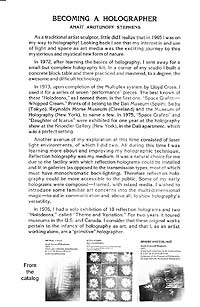
2020 Commentary by Al Razutis:
"Anait's essay (she signed her works with only her first name) is a bio summary specific to her introduction and interest in holography. It reads like the artist is placing herself into both a personal and cultural history of holography and his staking her claim as a 'pioneer' with a focus on the fine arts.
PFD copy (expandable) of this essay can be downloaded at http://www.alchemists.com/visual_alchemy/smca/franklin-essay-anait.pdf
" It is unclear to me if the curator requested all the essayist artists (myself included) to contextualize our own work, although the other essays contain such bio and self referential statements as well. To this critic and historian this essay is pretty much a footnote to the works themselves and relatively tame and insignificant on the subject of art and holography.
" Anait, with my direct participation as videographer and video editor, did assemble a biographical chronology of of her works that include her early sculptures, experiments with environments, and a complete recitation of her holographic works to the date of the video. The video could then be considered an adequate 'companion' to this essay as both focus on the bio and the works.
"The autobiographical video by Anait is titled ANAIT - DANCING WITH LIGHT WAVES", and is posted by me on You Tube here: https://www.youtube.com/watch?v=0pSLAGp0KvA&feature=youtu.be
"A comprehensive interview with Anait on her work and history was conducted by Al Razutis (this writer) in 1987 and published in "Wavefront" magazine later that year.
The interview which contains relevant material to this essay is posted at: http://www.alchemists.com/visual_alchemy/wavefront/wave9.html
"A short video of multiplex holograms (holographic stereograms, also called 'integrals' by Amy Greenfield in her essay for the catalog) by Anait, created at Multiplex Co. in San Francisco under the direction and guidance of Lloyd Cross. These were the holograms that Anait referred to as "Holodoeons" in her essay."
Views of these motion-picture holographic stereograms, or 'Holodeons' are on-line and posted on You Tube:
https://www.youtube.com/watch?v=anPBv32pMvI&feature=youtu.be
A short video of Anait and her works from the documentary "West Coast Artists in Light" is posted at You Tubetube link: https://youtu.be/DRHCLbBagRk?list=PL00A876600
A page to Anait's works, including her obituary, is posted on my web page:
http://www.alchemists.com/visual_alchemy/anait.html
Additional perspectives on Anait Stephens and her works is HERE below on this page
------------------------
This essay also establishes and argues for "artist who becomes a holographic artist" by virtue of taking up the medium, in Harriet Casdin-Silver's case it was within a high-tech environment at MIT with excellent tutors, co-workers. But she was also 'hands-on', an extablished 'multi-media artist' in the USA East, and willing to experiment with holography and art from the beginning.
2020 Commentary by Al Razutis:
"It takes self confidence and courage to say things that Harriet Casdin-Silver said about art and about holography culture in the 1970's. I found that refreshing in an otherwise pretentious and 'never saying what they really mean' scene."
"As I posted March 21st, 2020 here:
" It wasn't just Hilton Kramer who ripped into the 1975 holography show in NYC for its form and lack of content, but also one of the participating artists, Harriet Casdin-Silver, who wrote:
"I wanted to take my art out of that show [. . .] I thought it stank to high heaven. There was so little real art in it [. . .] But from the holographic artist's point of view, the art critics stood in the doorway, looked in and really saw nothing
[. . .] I never saw them at my installation. The show should not have happened, it was too early on. Typical people who had six weeks of holography called themselves artists." (Harriet Casdin-Silver)
Razutis 2020 commentary continues
"My First 10 Years as Artist/Holographer (1968-1977)" by Harriet Casdin-Silver is the definitive version of what she wanted to say for the Franklin Institute exhibition "New Spaces" catalog essay but didn't. It is included here not just for the record, but to set the record straight as to one of the remarkable figures in the origins of holographic art in the US and in history.
"This is a formal paper, its abstract reads:
"ABSTRACT -- The author reviews the decade of her career, with an analysis of her solar-tracked hologram series on Center-beam, a collaborative environmental outdoor sculpture by artists of the Center for Advanced Studies, Massachusetts Technology, and participating scientists. The author's philosophy and the politics of the art of holography is touched upon, and certain history and information in books and catalogues concerning her history is refuted."
"
Simply said (by me) Harriet Casdin-Silver's work in holography, outdoor installations and environments influenced many in the future generation, especially Sally Weber's diffraction grating large works. Casdin-Silver worked closely with one of the giants of holography Dr. Steve Benton is making some of her works or consulting with him. It is made clear from her Leonardo paper that she should receive direct credit for her works.
"
Like Anait Stephens on the west-coast many people assumed that Harriet and Anait did works that are actually 'done by others', which was patently untrue. Their work was notably 'hands on', and the record speaks to counter the revisionist history of others. And both were staunch 'feminists' in the holographic arts, each in different ways, and both histories are provided here."
This Leonardo 1989 essay is available for download from my website at http://www.alchemists.com/fb/leonardo_harriet_1989.pdf
Closing comment by Razutis:
"
Harriet Casdin-Silver came to holography already an accomplished experimentalist artist plugged into the US east coast tech and art cultures. And so she came with an attitude to explore and change the world in a manner that resonated with the 1960's art politics and cultural upheavals and experimentalism. She was pushy, she got her way, and she expressed strong opinions about art and holographers. Her essay for the "New Spaces" show titled "On Art, Technology, and Holography" is rather short, truncated, incomplete, and more of an introduction to the works she is exhibiting than a developed thesis." (AR)
"Holography does not make one an artist. For myself, it is a means of expression and communication. If l were not concentrating on holography - if Dennis Gabor had never invented holography - I would be working with other aesthetic media." (Harriet Casdin-Silver) "In personality Harriet was certainly a combatative type, opinionated, not afraid to say what she thought, that was my impression when I met her in Boston in the late 70's. Undoubtedly she made some enemies, but her brilliance, inventiveness and passion about political art made her stand out among the rest." (AR)
"Whatever form it takes, holography is sculpture of light. . . enlightenment . . . immaterial energy. Light is shaping imaginary
spaces. Light is fantasy, reality, politics, change." (Harriet Casdin-Silver)
Additional perspectives on Harriet Casdin-Silver and her works is HERE below on this page
-----------------------------------
"
Rudy Berkhout perhaps best exemplified that 'modernist impulse' towards 'minimalism', 'abstraction' in the romantic quest for 'unification with the cosmos' (god?), or at least as celebrated in the modernist traditions of the paintings of Kandinsky, Rothko, and colorists minimalists. The titles of some of his work reveal an affinity towards these traditions and artists. In the 1970's when Berkhout discovered holography and what he could create with it to create 'abstract' works was in itself courageous. Let's remember that many in the public have 'never seen a hologram' before, let alone might understand what 'abstraction of the cosmos' or of nature could mean when created 'with light' and without concrete - tangible references for the viewer to employ.
"The unification that Berkhout sought in a 'romantic quest' was a metaphysical unification which followed from a rich history and tradition of those abstractionists who sought to 'unify the cosmos' into a abstract glyph or 'meditation', a meditation that may suggest a number if meanings with clues supplied by the titles accompanying it.
"Rudie Berkhout's essay, "Unifying Science and Art" for the publication catalog "New Spaces: The Holographer's Vision", Franklin Institute Press, 1979 summarizes the artist's views on process, philosophy, and the technology of light he discovered in the mid-1970's: holography. His quest and aesthetics are philosophical, in pursuit of profound unifications as inquited by the artist and as expressed with light whose shapes are abtracted from nature. In the case of Berkhout's methods they can be considered as 'holographic optical elements' which manage or depict light accordingly." (AR)
As Berkhout concludes in the essay, this medium is perfectly suited to him for such 'unification':
"the visual impact of the hologram itself is perhaps a more succinct expression of this unification of art, science, and philosophy." (Rudie Berkhout)
PFD copy (expandable) of this essay can be downloaded at http://www.alchemists.com/visual_alchemy/smca/franklin-essay-rudie.pdf
2020 Commentary by Al Razutis continues:
""Writing in 1989 for Leonardo magazine, Rudie Berkhout's "Exploring a New Art Realm: Shaping Empty Space with Light" is a rumination on his roots, beginnings in holography in the mid 1970's, continuing under the formal guidance of teachers at Brown University, then completely on his own. It concerns some of the works on exhibit in "New Spaces" and sheds details and light on Rudie's interests in metaphysics, the abstract and the world of vibrations and forms of light.
"This essay is highly recommended for those interested in the birth of abstract holographic art and sets of holographic optical elements composed for light. It traces the development of one of holographic art's great 'colorists' and contains an account of his methods and objectives which informs his highly prized works to this day." (AR)
Additional perspectives on Rudie Berkhout and his works is HERE below on this page Al Razutis interviews Rudie Berkhout for Wavefront Magazine published in 1985 edition. This interview contains relevant material to this essay and is readable at: http://www.alchemists.com/visual_alchemy/wavefront/wave29.html
--------------------------
2020 Commentary by Al Razutis (AR) included:
"From the 'visual alchemist' that he was in the 1970's, and the 'novelist in the jungle' he attempted, Al Razutis returns from the south pacific in 1977 as a 'anarchist', 'media gangster', political artist (called 'troublemaker'), and most notably as 'an academic', who was employed from 1978 - 1987 as a full-time tenured "Associate Professor" at Simon Fraser University, Canada. During this time, which is the time of the Franklin Institute show, Razutis is in charge of a program of film - video - media studies - critical studies and sometimes holography, and will become a'shit disurber' for all of those 'comfortable in their institutions and 'legacy laundering departments'. That means he becomes more and more 'avant-gardist' in engaging with 'formalists' and 'structuralists' in the arts and critical theory.
"Now to make it more personal.
"In this Franklin 1979 exhibition I was exhibiting my earlier works (from the Visual Alchemy holographic exhibition of the 1970's), and at this time I developed an insistence on a critical language which was more academic, deconstructionist, and formalist than my earlier pronouncements in the 1970's had been." (AR 2020)
Something was bound to give and it was called 'fragmentation' of disciplines and theories.
------------------
"Al Razutis presents examples of his holographic works, including 'Surrogate (Dressed for Art New Vogue)', 'Aether Vane', 'Daddy's Spice Cabinet' and 'Field' in this 3 minute clip. Shot in stereoscopic 3D video in 1996 for 'Virtual Imaging' (by Razutis) and later incorporated into 'West-Coast Artists in Light' (Vol. 3).
"This video presents Razutis' concepts about 'Hybrid Holography' and holographic interferometry as art. Brief discussion of dichromate holography by Gary Cullen included.
Original material shot with Toshiba 3D camera and analog recorders in 1996 by Razutis and Gary Cullen.
For more on Razutis' work in holography visit his web page http://www.alchemists.com/visual_alchemy/holography.html
-------------------------------------
Razutis 2020 comments continue:
"There are three essays which are related to my thesis on culture and holography in the Franklin Institute publication and essay "Some Notes on the Art of Holography". These papers not only examine holographic culture and the 'art versus science' problems in language and valuation, but propose a semiotic approach towards decoding each genre.
"In the following three essays I talk about "two cultures" (the verbal/nonverbal, the grammatical/non-grammatical) which continually exert influences of what we term "holographic culture" and "holographic art". (AR)
The following urls and titles are therefore noted to contextualize the series:
'Art and Holography' (Part 1, 1985)
'Art and Holography' (Part 2, 1985)
Bride stripped bare: on the problems of interpretation of holographic art (1986)
--------------------
"
'Visual Alchemy' was the studio established by Al Razutis in 1972 to make holographic art, experimental films, video art, and various media experiments. The history of this studio is at http://www.alchemists.com/visual_alchemy/history.html
"The views on what is holographic art is built on what I call 'consensual reality' -- a world-view and culture has to be built on shared interests and values.
So, for the historian as well as the art critic, the task becomes to understand the macroscopic, the large, the durable in our culture. And in that capacity I set out to formalize this in my essay Some Notes on the Art of Holography.
"The gist of my essay was that while art in holography could be applied with any number of moderninst interpretations and goals, the inability of holography to adequately break from the gravity of mimesis suggested only one solution: a surrealism that engages the contradictions between the aesthetic and the empirical in our nascent holographic art. I will not restate the essay or its conclusion, they are abundantly on display in the work and links are provided. However, I will return to some of its conclusions in the 'Conclusion' section at the end of this piece.
"As for self-criticism, I don't need to include much of it. I'm not here catering to a crowd or pretending objectivity and absolute balance. But I will note a glaring weakness in my 1979 essay: it's hopeless stuck in a 'modernism' and a 'formalist analysis' that in the long and short term fell short of addressing the 'holographic' as a unique process and artifact. However, on that point I will elaborate later in 'Conclusion'.
"The idea of theorizing and proposing some structure to approaching the topics of holographic art, and from a perspective greater than a personal like or dislike, would become my primary interest in the academic 1980's while I served out my tenure as a professor in a media studies, history, and production program (which I headed) at a university in Canada.
"In addition to the academic writings were the publishing efforts ('Wavefront' and 'Opsis') which sought to extend the discussion to other contributors and reach a global audience.
"These publications and my role in them can be viewed on mt web site, and here is list of web articles available at www.alchemists.com/visual_alchemy/vc-write.html#holography
" -- (AR)
ADDITIONAL RESOURCES on Razutis' 'Holographic Hybrids':
Holographic 'hybrids' in stereoscopic 3D on YouTube - 3 min. - Al Razutis
------------------------------
'A SUITABLY TEMPORARY ENDING'
Al Razutis - March 24
"The black frame - the black mirror"
"Another reason why some can embrace anarchism, surrealism, and alchemy and consider it neither a holy trinity nor a contradiction." (AR) 'What would come in the 80's from Al is 'unfit' to publish here...'
"It was in the black mirror of anarchism that surrealism first recognized itself." (Andre Breton 1952)
Additional perspectives on Al Razutis and his works is HERE below on this page
-----------------------------------
Amy Greenfield, a relative newcomer to holography then was represented by one multiplex hologram and one essay. Her few further contributions are noted as befitting someone who came and went without much of a splash or effect that went beyond this exhibition.
(Commentary by Al Razutis 2020 where quoted:)
"To set the record straight, I never saw Amy Greenfield's work in person, not her experimental films nor her few multiplex holograms, one of which was on exhibit at the Franklin Institute show. Apparently, she did not continue working in hologrpahy past the early 80's, only a few works are noted by MIT archives. It is her essay, then, that is the focus of my interest, as she made a concerted effort to 'theorize' and 'criticize' the form of multiplex holography, popularly referred to as 'multiplex holograms', or 'holographic stereograms' or 'integral holograms'. It is this area of works that I plan to investigate in this essay and its implicatons for 'hologrpahic art'." (AR)
"Amy Greenfield's essay starts right off by making some bold assertions of "this new form" of holography (the 'Integral') that can show "time literally (is) converted to space". It makes other assertions which test the laws of physics, and violate what we know of relativistic physics (4-dimensional spacetime): that it's not a simple 'conversion', nor are the terms 'space' and 'time' interchangeable, nor can a multiplex hologram be considered 'proof'.
"Let's be clear as to what a 'multiplex' or 'integral' hologram is: a horizontal 'assemblage' (a printing) of film frames which are each 'printed in a holographic optical printer' as aerial images focused into thin vertical strips -- filmed moments, placed horizontally (there is NO vertical parallax) around an axis of rotation (the y-axis) to be displayed as a 'spatially multiplexed' hologram of 2D information which was recorded on individual film frames of a subject turning (along the y-axis) to reveal views of the horizontal parallax (only) of the scene... And when we view these holograms from an appropriate distance and height, the 'full image' appears to be suspended in the center of the screen and reveals itself 'turning' as we walk around (or as the cylinder spins on its vertical axis).
"As such, Amy's essay is an exciting (to her) venture into philosophy and aesthetics and making claims to science while having fun with ideas and words." (AR)
"She begins her essay:
"The 360'integral hologram is an apparition moving in mid-space inside a cylinder. The image moves, not realistically three-dimensional, but something more marvelous -- an illusionistic volume of a new kind based on complex interrelationships of space, time, and motion. One of the most fascinating and important of these manipulations, which creates this new kind of image, is the conversion of motion picture film time into the circular space of the integral hologram, or through the fourth dimension of motion.
"This new form is created because, in the process of converting film into integram, time is literally converted into space, and motion into volume." -- Amy Greenfield
2020 Comments by Razutis:
"How this 'conversion of time into space' is exactly done isn't explained, but the suggestions nevertheless are important, and spawned a whole school of holo-metaphysicians who saw in such holography a metaphor for the 'holo universe'. Along with such metaphysics came poetic language which included invented laws and universal correspondences.
<&quo;In Lloyd Cross' recollections concerning the birth of multiplex holography he included a story that after the making of one of the multiplex rainbox holograms everyone just stood around 'in awe'. It was that stunning to many as a creation, and the object or scene was less relevant than the 'holographic movie effect occupying virtual space' (yes, that's a virtual image). And some of these analogies to the cosmos of course were supported by theoretical physicists like David Bohm whose landmark books on the subjects of the 'holo universe' inspired many to follow a similar course in holography." (AR)
A reference page on the technology of the times: 'Multipex hologram technology'
"It is important to note that Amy Greenfield was not really a 'holographer' but a experimental dancer-filmmaker and feminist and media artist who wanted to 'use holography' for up to two multiplex holograms that were done in a facility for her. This is the mid 1970's when multiplex white-light viewable holograms, called 'integrals' or 'holographic stereograms' were made in a number of labs around the world based on the technology and designs of Lloyd Cross, Michael Kan, and others in the School of Holography and Multiplex Company in San Francisco, the place where all this tech came together and was 'born'.
"The Wave multiplex hologram 'integral' by Amy Greenfield - the credit reads "Holographic Film Company" which was Hart Perry's company - which is pictured in the catalog, was one of two she made during the entire time of her interests in holography and dance. (The MIT collecion has only one more example of a multiplex hologram attributed to Amy Greenfield - 3 x 120 degree holograms pasted together to form a 360), and then after the 70's there is nothing, and holography was abandoned by her." (AR)
NOTE: "Hart Perry's company and web-site has made claims for decades that Mr. Perry 'invented the multiplex printer', when the historical records clearly show that it was Lloyd Cross who visited Mr. Perry in NYC in the 1980's and 'helped him set up a studio and printer', which Dr. Cross did for many many other people. These false claims by Perry have been articulated by me (AR) on other occasions and are further documented in Appendix A. " (AR)
"I call out this essay to be a good example of mystification and obfuscation of what 'integral' holograms really are (spatially multiplexed movie frames in sequence), even if I laud it's opening foray into a land where the creation of a 'sculpted by time' space appearing in the center of a clear cylinder is nothing short of 'marvelous' for those who created these forms in the first place.
Turning 'time into space' certainly has some great poetic possibilities, it conjures up imagined 'space' or as Amy put it "sacred space", and it works not through physics and the mathematics of space time but by the use of poetic expressions that assert a 'reality' without having really to comprehend it, without having to really explain it, a reality which is more of an 'optical effect' and a poetic imagining than a new discovery of aesthetic art purposes.
Multiplex Portrait of Sharon by Lloyd Cross, an inventor of multiplex holography "Also featured in this exhibition was a 360 degree multiplex 'integral' (also called holographic stereogram by its authors) a "Portrait of Sharon" by Lloyd Cross and Sharon McCormack, which is in the collection of the Sharon McCormack Collection and Archives at Visual Alchemy studio and is documented in a number of photos and videos that I have shot of it.
90 sec. video 'Portraits of Sharon' by Lloyd Cross on You Tube: https://youtu.be/7iw4UJ0jjC4 featuring the multiplex shown in 1979 Franklin Institute exhibition.
Multiplex holography - portraits or movies? "Thinking that this matter remains unresolved, at first I would have thought that a 'head in a bowl' hologram or others which show a solitary figure rotating (and 'contained in a shape') from this time period are more adequately descriptive of 'space', a 'circular space', a space made up of increments of time, than Amy's "Wave", as was pictured in the catalog, which truly has no 'back side' nor is it a circular subject that satisfies her "paradox" views. So which is the best content to convey in a multiplex hologram? A portrait 'head shot'? A movie without a definite space to inhabit? All of the above? That was the Franklin Institute show proposition." (A.R.)
"I never saw Amy's hologram or true photos or videos of it, so I will posit that her essay, which is indeed provocative to both art and science readers, was a good enough reason to include some multiplex ('integrals') holograms in this show, because that form was indeed a 'marvel of the 1970's' and shaped the culture and the arts of holography ever since." (AR)
A whole page of multiplex (integral) holograms from the sources:
http://www.alchemists.com/visual_alchemy/holo_sharon.html#multiplex
Multiplex holograms in the public eye: Rolling Stone Magazine 1973
Multiplex Company Subject Turnable - with Lloyd Cross and laser multiplex holograms - 1973 'State of the Art Report - Holography 1973'
More on the subject of multiplex as art: 3.5.5 'Neither 3D nor a complete movie, the case of the multiplex hologram, but is it art'
------------- Page Top ------------- 'Legacy of the 1970's' -- text by Al Razutis unless otherwise cited.
To conclude, to provide an answer to "what is holographic art?" is to rescind nothing, but to reconsider these first years and see what stands out for us in 2020.
Before artists (like Bruce Nauman, pictured above, 'Making Faces' at Conductron Corporation new pulsed laser facility 1968) discovered holography, physicists and engineers had in fact 'invited the idea of the arts' because frankly that 'lab stuff' after the laser was invented was downright boring...
There was the excitement of art and technology in the late 1960's, and through the 70's, this 'multimedia' and 'expanded cinema' energy fueled much experimention into the uses, expressions and cultural products for the new inventions "lasers", "holograms", "high technology" and other fascinations. We had 'light shows' accompanying music acts in N. America, lots of 'intermedia' splashing across underground film and music screens. And a few 'essablished artists', like Bruce Nauman were engaged to experiment with the new technology of lasers by Dr. siegel and later he exhibited these holograms in NYC galleries. In fact they have been exhibited ever since, including a recent holograms by artists show in New York called 'Pictures from the Moon: Artists' Holograms 1969 - 2008'.
None of this early experimentation was intended to formulate a theory of holographic art. It was all hit or miss, try this or that, or in Nauman's case incorporate holograms in one's graphic explorations of 'making faces' and 'posing body parts' for the holo camera. It was not very sophisticated, used holography simply as a recording device of a scene placed in front of it, and was later justified only in context of the ('famous') artist's body of works.
This was the cultural environment for the Lloyd Cross, Jerry Pethick and Allyn Lite proposal for their holographic art, laser, and environment exhibition in 1970 at Finch College, as has been discussed in part 3.1.1.
Compare this exhibition contents with the works depicted in Gene Youngblood's landmark 1970 book 'Expanded Cinema' and we can clearly see the connections and note that as far as any 'art of holography', this synergistic, cosmic, intermedia and interactive 'art form' was here for good.
When the young 'holo arts' and artists came face to face with New York Fine Art critical establishment in the form of public exhibitions, they did not meet a hostile environment at first. The critics were 'open' to the idea of 'holography as art' - this attitude is reflected in NY art critic Grace Glueck's comments on the 1970 Finch exhibition:
"Meticulously installed and nicely paced, the exhibition still comes off as more lab
demonstration than art show. ( ... ) the three better-known artists have simply holographed their own 'brand'
imagery: Indiana, the word 'LOVE' assembled in metal; Nauman, his own face making
a face, and Ortman, a field of eggs. The others have made far more explorative (though
highly tentative thrusts into the medium. Mr. Lite contributes a couple of essays in color
achieved by varying his light sources; Mr. Cross shows, among other works, a -- 'special
needle' made by holographing a point of light, and one of Mr. Pethick's, the most
interesting of the lot, is a spatially ambiguous hologram of sand that, viewed from a
reference mark on the glass plate, resembles an earthwork seen from the air.
"Don't, as I've said before, expect an exotic esthetic experience. Even as a techno tool,
holography is still in its infancy and, judging by this show, artists' use of it can only
improve." -- Grace Glueck, NY Times, 1970
As it is remembered (by AR):
"Most of the new holographers who turned to 'art' came at it from varied and different backgrounds. There was no unifying influence, there was an overriding fascination with what one could do with this medium, not excercises based on precedents (which were scarce and scattered through the world). Further, most of these public exhibitions were done by the artists 'for free' (meaning, they didn't receive grants, or honoraiums for their participation). Call it the 'love of the art' and not a professional engagement, and at that point all responses (good or bad) to the works were taken 'personally'... So, it's a highly charged and very personalized environment, where 'ego' was paramount and 'reputation' was king."
------------- Page Top ------------- The first holo art genre that comes to mind is 'artist as holographer', or an artist who stumbled on, discovered or was invited to holography, but didn't participate in inventing anything. We can start with artist Bruce Nauman 'making faces' at Conductron Corporation in 1968 and then see the where it went in the 70's, 80's, and finally arrive back at where we started from. 'Believe me, there is a lesson here!' -- Al Razutis
Mr. Nauman was invited in 1968 by Conductron execs to 'make holograms' in pursuit of their declared interests to provide something more 'interesting', more 'artistic' in an otherwise boring lab image generating system. They wanted to 'sell holography', sell the technology, sellthe use of holograms in displays and they wanted to position themselves as the leaders of the pack. They even wanted to 'make holographic motion-pictures at Conductron!' This history is amply documented in Sean Johnston's 'Holographic Visions' book and needs not detailed examination here.
Here, in Mr. Nauman's series 'Making Faces' not only were the holograms exhibited (and continue to be exhibited) in galleries in NYC, but 'studies' and graphic photo reproductions in 'yellow' of his lips making faces ("Studies for Holograms") were exhibited, collected and sold for 'big money'. This is the business of holographic art.
"Is this the scene of holo-auteurs yet? Yes it is, and we're barely scratching the surface." (AR)
This is a good time to include a short Face Book conversation between Hans Bjelkhagen and Al Razutis (the author here) as it pertains to this art, and this form of 'holographic art', which is to say this is art, done by an artist, who exhibited this work in public and fine art galleries, and the case is made that this work must be, and will be included.
"Al, here are books about Bruce Nauman which may interest you to learn more about his art.
"His art doesn't interest me Hans Bjelkhagen, and reading some more books on it won't make my to do list. The example of Nauman being the 'first artist to show in a gallery some holograms' in the USA (with his making faces pulsed laser transmission series) I use as a signpost of where the 'art of holography' went from 1968 in the USA, and I start with Lloyd Cross and his Michigan and NYC show. In other words I start with a holographer who turned to art, rather than an artist who dabbled once or twice in holography.
"Nauman is an established artist and his holograms have been sold for higher prices than any holographer has been able to get. I know that the price has nothing to do do what it is, only WHO created it. As Carl Fredrick Reutersward mentioned that it is only the signature that counts. Pratt Muller Art Investment company in Switzerland sold paintings only containing the artist's signature. By stretching the signature and make it lager you can sell it for a higher price. If an established artist make something it automatically becomes an expensive piece of art, even if it is not an attractive art piece. There are many such examples. I agree with you about Bruce Nauman's holograms helping installing them in a gallery in Switzerland for a big Nauman exhibition there a few years ago. But Making Faces were not only holograms but also drawings by him included in the exhibition. Making drawings is something you expect an artist being involved in. The most difficult for a person who wants to become an artist is how to get started, what to do, how to get attention, etc. After you have past the stage you can get away with almost anything and art collectors will pay high prices. It is only WHO made it and not WHAT it is that counts, am I right or wrong Al?
"Thank you Hans Bjelkhagen for your reply, and the twin issues you bring up ('the business of art' and the 'business of holographic art'), and for your role in this Nauman holograpy and your familiarity with it.
The issues you bring up are central to 'what happened to holographic art' in terms of the questions 'is it the artist' or 'is it the art'.. And then there is the question of 'institution' (gallery) - in Nauman's case, the Knoedler Gallery in NYC in the 60's - 70's which was the site of a great fraud... (they sold 90 million $ of fake art / forged art, that kind of fraud)...
Good questions need good answers. Will respond soon."
The 'first holography art exhibitions' in the US in the late 1960's have been covered in the 'Finch Exhibition' descriptions, including critical response.
They represent the collaborative efforts of the following three individuals - links to their 1969 bios provided:
This background falls squarely within the 'experimental' and 'synergistic' 1960's and 1970's that dominated much of the young generation's attention then. To combine these three bios, and the range of experience and interests they represent is to understand the 'intermedia' 1960's and the cultural products that were created then.
To repeat what I wrote earlier (especially for those who weren't there in the 1960's) is to restate it for the record:
"... This proposal for 'holographic art' presents an exhibition concept that includes laser light shows, sculpture, labyrinth, in other words, a "multimedia" and "intermedia" exhibition what was indeed in keeping with those times (think: Experiments in Art and Technology (EAT) in NYC, think Intermedia in Vancouver Canada).
"Think Youngblood's "Expanded Cinema" book, 1970 a copy of which in pdf is downloadable from my web site:
http://www.alchemists.com/fb/expanded_cinema_youngblood.pdf
"
What does "Expanded Cinema" (Youngblood, 1970) have to do with holography and holographic art in the 1970's? And works done at Visual Alchemy? Everything.
"Here is my web page on it. http://www.alchemists.com/visual_alchemy/intermedia-holo.html
Mar 19, 2020, 1:22 PM
"Simply put, it hardly mattered 'what your subject was' in those early days of experimentation. Was it a sculpture, a photography, a found object, or was it 'light'? Everything was fair game for experimentation. The categorization of 'art', and 'influences' and branches of 'modernism' and 'post-modernism' would come soon. Very soon..." (AR)
------------- Page Top ------------- We're focused on N. American holo art, not doing a survey, not visiting Europe or Russia. Other parallel histories like this wait to be written there. Not having been involved in the 'Holography 75 - The First Ten Years' show in NYC, I turn my attention to the contributors and written essay writers in the Franklin Institute 'New Spaces' exhibition in 1979 for more clues and more 'genres'.
Auteurs and artists came in the form of Anait Arutunoff Stephens and Harriet Casdin-Silver, each coming at it from a very different direction: Anait is a formalist whose modernist sculptures (in cast resin) or mylar environments (in NYC) were created as 'attractors' to her name, personality and work. Conversely, Harriet dabbled in everything, beginning with steel sculptures, environments, secured institutional (MIT, Brown University) support and facilities, and worked hand in hand with scientists to explore every aspect of this new holo-tech. But both came with an 'attitude' to 'prove themselves' in an otherwise boys club of 'techno-dicks' (some calling themselves 'guys with big lasers') looking for some 'holo gurls'. (Yes, culture can be that banal once the 'lab experience' gets old in some quarters.)
'The romantic auteur'
Anait was the classic and consumate 'modernist', falling in love with 'Monet's Lillies' later on in life in a series of pulsed laser holograms placed in a installation. She preferred to work alone, she was wealthy and could afford hired help when needed. During the 'formative' 1970's she experimented with single-beam reflection holograms (Denysiuk method) in single or multiple-mosaic configurations, she experimented with multiplex movie holograms in a series she titled 'Holodeons' ( < video link), and she continued her work 'hands-on' (meaning, she actually handled the plates, did the chemical processing) in defiance of a heavily male-dominated technical environment (and some loud-mouthed 'techno dicks' who termed Anait's work "dimograms"). Some of these guys would later grow to regret that label because the author (Al Razutis) who was a 'friend' to Anait would never let them forget it... This is to confirm the sexism in the arts, where attractive women artists had it tough, the early pioneers especially.
Anait's aesthetic could be summed up as 'everything moderninst', and part of the 'romantic quest', from works tending towards abstraction, simplicity to later works which were impressionist and 'messy'. At her death her work was donated to the MIT university archives along with her memoirs. What is maintained outside of this is by me in my series West-Coast Artists in Light and my page on Anait Stephens.
------------- Page Top ------------- 'Whatever form it takes' is how Harriet Casdin-Silver engaged and performed the subject.
"Whatever form it takes, holography is sculpture of light. . . enlightenment . . . immaterial energy. Light is shaping imaginary
spaces. Light is fantasy, reality, politics, change." -- Harriet Casdin-Silver
Harriet was the consumate post-modernist, experimentalist and fortunate to be situated in the proximity of Massachussetts Institute of Technology and other eastern institutions with their cutting-edge facilities and faculty open to working with artists like Harriet. Her 'pugnatious' attitude didn't win her soapy art friends but it informed the boldness with which she explored holography in relation to sculpture, installation, performance and even her animated lectures.
If her Franklin Institute 1979 essay is on the light side, she makes up for it with her 1989 Leonardo essay which attempts to set the 'record straight'
http://www.alchemists.com/fb/leonardo_harriet_1989.pdf
It is here that she lays claim to the 'intermedia' foundations of post-modern holographic art, to the 'environmental arts', to the 'political' art of feminist expression, these were the art that she practiced in the 1970's - 1980's, and it is here that these foundations are illustrated by examples which survive her in the manner that the history of art shows favor on those who are connected with 'the big east'.
In her Leonardo essay, Harriet has no qualms about declaring herself being 'first' in various forms of holography, for example, "This was the first multicolor
white-light transmission art hologram." ('Hologram IX') in reference to one of her many collaborations with Dr. Steven Benton (the inventor of white-light transmission holograms called 'rainbow' holograms).
UPDATE to this section: I have now (in 2021) concluded that there are some doubts as to Harriet's claims, especially since many of such claims of authorship exclude the necessary participants, like the holo artist Rudie Berkhout who was responsible for some of her works, or the scientist Steve Benton who also was responsible for some of her works. This observation extends to other artists mentioned here, but this essay cannot cover and evaluate all the artist histories and works. It's fair to say that Harriet's focus was and would continue to be a "three-dimensional luminous energy
floating in space, completely disengaged from the plate. This fascination (to make light a 'material object' was represented by her 'Holos 17' hologram which acts as a 'holographic optical element', and her much traveled 'Equivocal Forks' I and II where the pseudocsopic and projected image is seen as separated from the plate (hovering between the holographic plate and the viewer in space).
Her other works to include group creations ('Centerbeam' installation, solar tracking installations, group sculptures) were along the line of installations in public and art venues and guaranteed to get attention and influence future generations of artists (like Sally Weber) to combine architecture and design and diffraction gratings color effects to 'create environments with light'.
So the 'genre' here is centric to the personalities and interests of the respective artists, Anait Arutunoff Stephens and Harriet Casdin-Silver. It is dependent on their respective capabilities to generate interest in the various aesthetic interersts that they expressed in their art. It's all about them and their 'journey' through the wonderland of holography, it's centric to their personalities as 'art stars'. And with that would come the 'birth of the star' and the fading, once these aesthetic forms propagated through that 'known holographic art universe' of the 1970's and 1980's and its energy dissipated into other activities and other interests that were carried forward by next generation artists.
"The works of Rudie Berkhout became a 'genre' in and of themselves if only because of the singular purpose to which he applied himself: to create a 'world' of light objects, populated with landscapes abstracted through the elimination of all detail, leaving only 'contours' and 'lines' of light floating in a darkness of unknown proportions.
In his self-declared quest to 'unify science and art' Rudie engaged in what I term a 'romantic quest', and I describe it accordingly:
"The unification that Berkhout sought in a 'romantic quest' was a metaphysical unification which followed from a rich history and tradition of those abstractionists who sought to 'unify the cosmos' into a abstract glyph or 'meditation', a meditation that may suggest a number if meanings with clues supplied by the titles accompanying it."
Papers - Essays by Rudie Berkhout illustrating his process and interests:
"This Berkhout world of abstractions, a minimal world without real scale or dimensions, an imaginary world created 'synthetically' by the use of lenses, mirrors, 'optical elements' is a pre-cursor to world of 'virtual reality' and 'computer graphics environments' which would come decades later. It's a synaesthetic worls freed from 'mimetic representation' of reality, free from 'gravity', free from everything which would contain or define it. One could say this is 'visual music' which is played out with light and by instruments of new technology including the lasers. The connection to early 'laser show' displays (as in Lloyd Cross' company 'Sonovision' in the 1960's), or to 'light organs' is unmistakable. Light is vibrating energy. However in these holograms it is 'frozen in time', and that made for an eerie combination." (AR)
Rudie Berkhout can describe his process and his view of the holographic world:
" A lot of my work happens by coincidence. I play with the medium, learning
what it can do. Usually, I do not have any specific imagery in mind. I experiment with simple forms and shapes to
see how the medium responds. After observing the results, I select the elements that seem to be in harmony and
that reflect some of my feelings about
the world we live in. I like to share my
sense of wonder and awe, love and joy,
trust and faith. To me the physical
world is a most miraculous holographic
creation that is all too often taken for
granted." -- Rudie Berkhout, 1989, Leonardo
I call this a 'genre of holographic art' for the simple reason that it has spawned a number of works by a number of artists who are all fascinated by the 'metaphysics' of it all... The metaphysics of this practice is derived from poetic speculation and assumption of 'hidden secrets' in the universe which cannot be easily grasped from the mere appearance of things. 'Energy', 'light', 'dimensions' take on a special meaning in metaphysical interpretations. Let's remember that 'meta' means 'without' and that metaphysics means 'without physical basis' which is to say that there 'must be a higher order of things'. Well, that's the speculation.
The metaphysics of this is tied to the very real investigations going on in theoretical physics, experimental physics concerning light, dimension and the nature of our universe. In that later category there are suggested any number of artistic possibilities to express this fascination of ours, possibilities that can derive even from Pythagorean mysticism ('music of the spheres', 'macrocosm and microcosm', 'everything is vibration) or borrow freely from 'new age' spiritualism which is an amalgam of all the esoteric branches that have come before.
This genre is 'immersive', one can really 'get into it'. It's not just 'symbolic' but 'interactive' as holograms typically are when viewed. The creation of these 'reality constructs' (scenes, patterns, mandalas, designs) by employing focused light and holographics has given them a kind of legitimacy, a 'reality' that they may otherwise not enjoy, or enjoy only as mere 'graphics' or 'poems'. In this manner, there is no argument for or against this genre of hologrpahic art expression. One can 'like' or 'dislike' according to one's preferences. There is nothing 'objective' here, we are talking about subjective eperience and one's 'relationship to the universe' which can result in a pleasing or unpleasing experience of things, like our experience of 'music' comes with varied results.
To make a multiplex hologram (that term was used in the 1970's to specifically denote a hologram created from a number of photo or movie stills of a horizontally rotating subject) was to make something quite 'miraculous' in the 1970's. Everyone wanted 'one of them'. People 'ordered them made' from movies they provided to the Multiplex Co. in San Francisco (Lloyd Cross and associates) where these holograms were invented and perfected over time.
Multiplex Portrait of Sharon by Lloyd Cross, an inventor of multiplex holography "Also featured in the Franklin Institute 1979 exhibition was a 360 degree multiplex 'integral' (also called holographic stereogram by its authors) a "Portrait of Sharon" by Lloyd Cross and Sharon McCormack, which is in the collection of the Sharon McCormack Collection and Archives at Visual Alchemy studio and is documented in a number of photos and videos that I have shot of it.
90 sec. video 'Portraits of Sharon' by Lloyd Cross on You Tube: 'The Story of Multiplex' & School of Holography by Lloyd Cross (.PDF) A number of impersonators of the 'inventors' appeared, some claiming to have 'invented the multiplex printer' all by themselves! (See Appendix A for example of such impersonations.) So, what is it about this transparent moving image 'suspended in the center of a cylinder' that caught people's imaginations? Was it because it seemed like a 'magic trick'? A 'disembodied head' trick like in the old vaudeville days, a 'mystery' like the ones promoted by Robertson in 1800's Paris, a subject of a Rolling Stone article in 1973 on the 'remarkable future for holography'? It certainly was a wonderful invention, 'but was it art'?
The multiplex hologram was not 'full 3D'; the process lacked a vertical parallax (to be able to look over / under the image scene), and when one tried the color changed (!) as did the image scale slightly. Basically, the hologram was a series of thin vertical strips of '2D motion picture frames' that were 'projected into a cylinder space' (as a virtual image) and the subject moved(!) because it was a recording in motion-picture film. That was the real selling point here.
Amy Greenfield presented a solo multiplex hologram 'Wave' of which I have only a grainy B&W catalog photo. This film of her's (a short clip), with a seashore 'wave' and figure appeared to occupy a 'virtual volume' in the center of a cylinder, a volume (screen) which featured movement when one walked by or the cylinder spun. In that Franklin Institute exhibition of holography in 1979 Amy boldly declared in the catalog that the work showed how "time is literally converted into space, and motion into volume.", a statement that is poetic, but not a very accurate or scientific description of a projected film image and its real 'place'.
Along with the discovery of such holography in the late 20th century came theories of 'holo-cosmology', a mathematical physics theory of reality and the universe by physicist David Bohm, a 'holographic brain' theory by neuro-biologist Carl Pribram, and a host of other theories all attesting to the 'holographic nature of the universe' -- topics which continue to be explored today and include 'quantum holography' and 'holographic entanglement' theories.
For a multiplex hologram to assume the status of 'art' it would have to assume the status of an 'experimental film art', meaning that the artistic interpretation of the subject via cinematic and holographic means would have to be considered 'art', and paramount, not an afterthought or a function of the projection - viewing technology or any optical effects.
In a sense, every multiplex movie is an 'experimental film', and the question of 'is it experimental film art?' can only be examined on a individual case-by-case basis with focus on the maker (filmmaker, artist), their ideas, intentions, execution and how it came across to an audience. As a genre of filmmaking, as a genre of art, it can be situated at the 'crossroads' of our investigation, but it cannot lay claim to being any 'foundation of holographic art'.
As a recording - display process multiplex holograhy has some 'artistic possibilities'. But one thing is for sure, a multiplex 'portrait of an artist' (let's say, a portrait of Andy Warhol) does NOT make that multiplex hologram portrait in itself a 'work of art'... rather, it can be an inept intepretation or inept use of the medium, as was the case with Jason Sapan's portrait of Warhol which is pictured in the discussion in Appendix B.
A page dedicated to multiplex holography and the works of Sharon McCormack, Lloyd Cross and others in the field is in the McCormack Collection and Archives which is administered by Al Razutis the author of this essay and contains extensive documentation on the subject.
Multiplex holograms in the public eye: Rolling Stone Magazine 1973
Multiplex Company Subject Turnable - with Lloyd Cross and laser multiplex holograms - 1973 'State of the Art Report - Holography 1973'
------------- Page Top ------------- After decades of exhibitions, essays and news stories, we appear to arrive at the beginnings and have to ask 'what happened?' lest we forget that we were on the journey in the first place.
This is what happened: 'holographic art', otherwise known as the 'art of holography', was attempted, celebrated, taught in schools and then 'withered away'... at least that is my perception after doing this work since the early 70's. I see none of the enthusiasm I saw in the 1970's, the 1980's, none of that 'wow factor' that accompanied holographic exhibitions which I installed or attended. I see a lot of 'been there done that' mindset operating, now migrating to 'virtual reality', 'augmented reality' or other forms of interactive 'entertainment'.
As an art form, 'holography' has retreated to the safe confines of galleries and museums that only show 'established artists', and these exhibitions are infrequent and under the radar for most.
I will examine a few current (2020) assumptions about holography, it's history, and its validation, and from the perspective of those curators still showing holographic works 'by artists'.
What do the current curators and critics say?
"Major artists like Roy Lichtenstein and Louise Bourgeois have experimented with holography, but it has yet to be taken seriously as an art form." Allison Meier continues by first quoting another artist: " 'When I saw a hologram for the first time, I felt both wonder and familiarity with the three-dimensional world that lay beyond the holographic space,' writes artist Ana Maria Nicholson in Leonardo. 'It seemed like the space of dreams and mental images, but it was here and now, sharing our world, coexisting with us.' Her article was part of a 1989 Holography as an Art Medium special double issue of Leonardo. It was published at a pivotal moment for the art hologram, which had reached large audiences through popular exhibitions, but failed to find a footing in the mainstream art world."
"
As author D. Tulla Lightfoot observed in the same Leonardo issue, although the number of holography exhibitions had recently increased, 'these shows have not taken place in traditional art galleries or museums in New York City. Correspondingly, very little has been written about holographic art in the traditional art magazines and journals based in New York, while video art and computer graphics have not seemed to fare as poorly.'
"By the late 1980s, the crowds thinned. 'Ironically, the falling appeal was associated with holograms' widespread availability and the consequent trade-offs in quality,' (Prof.) Sean Johnston writes.
"Holography continues to be practiced by some artists, but it has remained a niche art form since its 1970s boom. One reason may well be that holograms must be experienced firsthand, and without exhibitions it's hard for them to gain a bigger audience. Recently, however, there's been some renewed attention. The HoloCenter will return with new work on Governors Island in New York this summer. In March of 2019, the J. Paul Getty Museum in Los Angeles acquired 105 glass plate holograms from C-Project, an early 1990s initiative to involve major contemporary artists (including Roy Lichtenstein, John Baldessari, Dorothea Rockburne, and James Turrell) in holography and in turn promote its artistic potential. Eerie red holograms of cages and chairs contained in bell jars, made by Louise Bourgeois as part of C-Project, are currently on view in New Order: Art and Technology in the Twenty-First Century at the Museum of Modern Art in New York." -- Allison C. Meier May 7, 2019
Not a very encouraging picture!
Unfinished business
Thinking ahead in 1979, here's where I had left off with my comments on the Franklin Institute 1979 exhibition: 'Notes on the Art of Holography':
"Mimetic holography reaches a curious apex in what I will loosely term pure holography. Rather than presenting a framed plate, conspicuously present as a formal gesture of rendering, the holographic plate or film is rendered almost invisible -- for example, suspended in a room, with little or no ambient light -- and the image is rendered in space behind or in front of the plate in orthoscopic configuration. The creation of image-objects floating in space, with whatever contained field of view, and free from contextual confines, is, to say the least, unnatural. In that it does not readily conform with our everyday experiences, it is extraordinary. (On a technical note, this process also can be accomplished by projecting a pseudoscopic image into a spherical mirror and reconstructing the final result as orthoscopic image in space.) Hence, the pursuit of realism in holography reaches its apex of expression in the creation of surrealism.
"A more fruitful area of investigation occurs when we consider two hybrid forms of holography: the graphic-hybrid hologram and the sculptural-hybrid hologram. The first category is representative of works that are usually presented in the familiar graphic format (i.e., framed, and hung on a wall), and feature a play on the flatness of graphic image(s) and context of presentation, as contrasted by the depth and dimensionality of the holographic image.
( ... )
"The second category, that of the sculptural-hybrid, is intrinsically more complex (and more interesting). Works of this nature feature a combination of sculptural (spatial) artifact and holographic image, each of which contributes to a resultant synthesis. The Multiplex stereogram can be considered in this light, but once again it fails to articulate clearly the synthetic relationship between its evident shape (the cylinder) and the holographic image contained within. (The magic of the artifact in the bottle will not suffice as aesthetic gesture). I have only seen a few Multiplex stereograms that have even approached a successful synthesis, and one ("Three Objects in Space" by Anait) is largely successful because it makes explicit use of the limitations of this process (namely, spectral rendering in place of vertical parallax). In other words, it is specific to the material and process of expression, and clearly articulates this relationship.
( ... )
"The sculptural-hybrid, moreso than the graphic-hybrid, is fundamental to holography because both aspects of the hybrid -- the sculptural and holographic -- are naturally related, and to divorce them completely would amount to a cessation of aesthetic dialogue between matter and light." (AR)
"The gist of my essay was that while art in holography could be applied with any number of moderninst interpretations and goals, the inability of holography to adequately break from the gravity of mimesis suggested only one solution: a surrealism that engages the contradictions between the aesthetic and the empirical in our nascent holographic art." (Al Razutis - AR)
ADDITIONAL RESOURCES on Razutis' 'Holographic Hybrids':
Holographic 'hybrids' in stereoscopic 3D on YouTube - 3 min. - Al Razutis "I could then observe that since the 1970's there was a proliferation of interest, of works especially by 'new holographers' which featured forms of 'hybrid' expressions which combined the holographic image with graphic or sculptural motifs." (Al Razutis)
------------- Page Top ------------- Who is being exhibited now?
"The short answer is "famous and established artists", like Bruce Nauman who is still making holo-faces in galleries fifty years later... the 2012 exhibition 'Pictures from the Moon' is notable and features a series of holograms from Larry Lieberman's "C-Project" in the 1990's which put a lot of other famous and established artists on the holo-map because of their beautiful quality... now and then exhibiting, but believe me, we're not done yet!" (AR)
The curator speaks:
"Artists as diverse as Louise Bourgeois, Eric Orr, Ed Ruscha, and James Turrell have all made holographic works that draw on the medium's ability to replicate three-dimensionality and deep space to expand upon themes they so successfully mined in other formats. The haunting, domestic objects and sinister interiors that define Bourgeois's work appear wholly present in her untitled holograms from 1998. In Ed Ruscha's series of holograms produced the same year, the phrase 'The End' floats at various depths in the picture plane, set against animated lines scratched into a celluloid surface, and offering a new twist on the interplay between text, landscape, and spatial representation for which Ruscha is known. Eric Orr and James Turrell, in whose works light and space function as artistic mediums, both created holograms that synthesize color, shape, illumination, and form. Turrell, who has made an extensive body of holographic work and who continues to work in the medium pushing it forward into challenging new realms, produced the largest and most recent hologram in the exhibition."
"In this current age of techno-dependency, "Pictures from the Moon" offers a view of the persistent attempts by artists to wrest something more from technology than that for which it was invented. As advancements in 3-D technologies are demonstrated in new formats of television and film production, the enduring hologram continues to mesmerize by expanding the artistic and visual fields that lay before our eyes."
-- Jenny Moore.
'Pictures from the Moon: Artists' Holograms 1969 - 2008' exhibited in 2012 at the New Museum was curated by Jenny Moore, Associate Curator.
NY Times art critic comments:
'Let there be Light, in Three Dimensions' - Aug 23, 2012 -- by Martha Schwendener
""The current silence around holograms -- 'Pictures From the Moon' at the New Museum could easily be titled 'Remember Holograms?' -- is particularly interesting...."
( ... )
"Abstraction and color are the focus in Eric Orr's four untitled holograms from 1995 and James Turrell's 'Untitled (22NSGB)' (2008). Mr. Orr's works feature vertical planks of color hovering in complementary color fields, a bit like a 3-D Blinky Palermo painting except that the color planes move like louvered blinds as you pass in front of them. Mr. Turrell's work, like his larger light installations, involves color represented in ethereal, geometrically abstract form; its two curved triangles appear to merge with each other and the space around them.
"The other four works are by Ed Ruscha and Louise Bourgeois. The pair by Mr. Ruscha, 'The End #1' and 'The End #2' (both 1998/2007), replicate in three dimensions the two on-screen words that mark the end of a film. Ms. Bourgeois's untitled deep red holograms from 1998 depict empty chairs suggestive of dollhouse furniture, one on a pedestal under glass, that fit with her lifelong project of undomesticating the accouterments of domestic life.
( ... )
"But 'Pictures From the Moon' is really more of a teaser than a full-blown show; it leaves you wanting a much broader treatment of the subject, which includes the pioneers and practitioners mentioned in the wall text: Margaret Benyon, Rudie Berkhout, Jody Burns, Harriet Casdin-Silver and Dieter Jung. (Other artists who dabbled in holograms include Salvador Dali, Simone Forti, Michael Snow and Stan VanDerBeek...
"The show is skewed instead toward well-known artists who used holography and toward works made well after its heyday. But there is no question that holograms aptly demonstrate the quasi - mystical relationship humans have with technology - and photography in particular, which has often been harnessed to represent the supernatural. (Holograms are not unlike 19th-century ghost photography and ectoplasm experiments, and there's also a wax-museum chilliness to them that conjures a long history of photographing the dead.) No surprise, then, that holography inspired artworks and a dedicated museum or that it was quickly stifled into bureaucratic forms, like the postage stamp, or sublimated onto the already addictive medium of the credit card."
Source: https://www.nytimes.com/2012/08/24/arts/design/holography-in-pictures-from-the-moon-at-new-museum.html
------------- Page Top ------------- So let's nail down what is of interest to the fine arts now
And not be in a hurry. It is clear now that 'big name artists' who come with an extensive body of works in various mediums and who have expressed themselves in holography using the talents, expertise and technology of un-named holographers are now situated as the focus of 'what is of interest to the fine arts now'.
In this last section, I will make extensive reference (in the form of quotes with which I will have dialogue) to the brilliant, insightful exhibition catalog essay by Gregory Moynahan 'Holography and the Aesthetics of the "Hyperreal,"' ( download at academia.edu ) for the exhibition, 'Pictures from the Moon: Artists' Holograms 1969 - 2008,' New Museum, New York, July - September 2012.
For example, let me quote Professor Moynahan's following paragraphs with works underlined by me to show 'what is of interest', what gets a response, what's mentioned and memorable, and then we can continue to examine the deep issues of representation and culture.
"The haunting, domestic objects and sinister interiors that define
Bourgeois' work appear wholly present in her untitled holograms
from 1998. Ruscha's series of holograms, produced in the same
year, feature the phrase 'The End' floating at various depths in the
picture plane, set against animated lines scratched into a celluloid
surface. This interplay between text and spatial representation
offers a new twist on the combination of landscape and language
for which Ruscha is known. Orr, in whose work light and space
function as artistic mediums, created a set of holograms in
1995 that synthesize color, shape, and illumination in forms of
extraordinary presence and vibrancy.
"In 2007, James Turrell, an artist who has continued to expand
holographic technology, began production on a large number
of holograms that combine aspects of both transmission and
reflection holography. Integrating his 'light and space' installation
work with the unique properties of holography, Turrell transforms
'pure light' (as the artist describes his medium) into holographic
shapes of intense color and depth." -- Gregory Moynahan, 2012
My first response, but not the last:
"One could say that these desired (as underlined) and 'memorable' qualities of the works being described by Gregory Moynahan and as on exhibit 'Pictures From The Moon' 2012 have been present in the works of other lesser-known artists throughout the first decade I examined. Certainly, we have seen here in this short history of mine references to works where 'light becomes form', references to interplay of text and subjects, to personal iconography occupying 'modernist' and 'post-modernist' cultural space.
"To be curated and preserved, it's clear one needs a high profile venue, intelligent writing, and excellent presentation because 'rough edges' and 'sloppy prose' just won't do here in the 'big leagues'. In the absence of developed theories of holographic art (that are embraced by the fine arts establishments) we have to accept that 'quality' is now reserved for those 'more developed' or 'better known' or 'more famous' artists. It is therefore clear then that a 'very special' status which then becomes the rationale for showing these artists, and ignoring other lesser-known artists or holographers.
" It should also be clear and noted that the actual creators of this work, the holographers who 'made these holograms' for the artists will remain backgrounded in this kind of literature as 'craftspeople' have been... and that's unfortunate, because many of these qualities under consideration and praise were directly provided by the holographer technicians to the projects, and I argue that one must consider that a 'creative contribution' and not just some 'technical (anonymous) thing'.
"The implications for holographic art and artists are clear as I paraphrase Moynahan: 'This is what we curators and gallerists find interesting. Don't waste our time with kitsch!' I don't think I have to underline more, but the following paragraphs are excerpted to conclude our story." (Al Razutis - AR).
Continuing with Gregory Moynahan (2012), to the end this time:
"Although
holography has been with us for more than five decades, it
remains an elusive and surprisingly futuristic technology. The
artists in this exhibition use holography to show us bodies and
objects in a completely new light, and reveal another chapter
in the enduring history of artists using technology creatively." (GM)
( ... )
"Holograms have had a complicated relationship with art history.
Although once proclaimed to be the medium of the future,
with predictions that the technology would be as important an
invention as the printing press and replace such traditional
means as painting and sculpture, holography never fulfilled those
expectations. It remains a marginalized medium, one equally
entangled with esoteric technology and with lowbrow kitsch.
That holography has remained in this position is peculiar when
one traces its development within the context of other artistic
mediums. Artists began to experiment with a range of innovative
technologies, like photography and video, in the 1960s. These
formats acquired greater acceptance around the same time
that artists first gained access to holographic technology. While
photography and video are commonplace in contemporary art
today, holography remains suspect." (GM)
( ... )
"The characteristic properties of holography
continue to amaze. In addition to creating the perception of
an object in full volume floating in space, a hologram can store
vast amounts of information. ( ... ) And yet,
as unique as holography is, it is often confused with other visual
technologies -- those that are far simpler, such as lenticular printing
and Pepper's Ghost. These formats give the appearance of three-dimensionality
while holography contains the actual information
that demarcates three-dimensionality. With this extraordinary
potential, it is not surprising that artists would be compelled to use
holographic technology creatively." (GM)
( ... )
"As holography became more widespread and commercialized -- its height of popularity evidenced by the holographic image of an
eagle printed on the cover of eleven million National Geographic
magazines in 1984 -- the aesthetic potential of the medium became
eclipsed and fine art holograms conceded to a deluge of hologram
key chains, paperweights, and jewelry." (GM)
( ...)
"Despite holography's appearance as one of the few entirely
uncharted new mediums for art in the second half of the twentieth
century, its acceptance by the art community was remarkably
slow. Surveying the reception of laser holography in art from
its invention in 1962 through 1993, the critic Edward Lucie -
Smith noted that critics had almost universally considered it as
'irredeemable kitsch.'
"Most critics found neither the choice of content nor the form of
the work of high quality; many were perplexed by the nature of
'images [that] were disturbingly there and not there.' There are, of
course, some aesthetic grounds for these complaints. Holograms
suffer from what might be termed the 'stereoscope effect' where,
precisely in their timeless realism and infinite depth of field,
animate beings in particular often appear hauntingly unreal, as
if revealed through a new type of taxidermy. Due to the relative
complexity of the holographic process, it is also difficult to match
medium and content reflexively, and thus to comment on the form
of representation in the manner of visual art traditions such as
those ranging from Dutch Realism to Abstract Expressionism.
Underlying these aesthetic issues is perhaps a more fundamental
theme that has haunted the aesthetics of holography: the relation
of art and reality itself. Indeed, from some quarters this relation
seemed to be the salient feature of holography. In 1986, Umberto
Eco used holography as the framing model for his essay 'Travels
in Hyperreality,' describing it as a peculiar art 'that could only
prosper in America, a country obsessed with realism, where, if
a reconstruction is to be credible, it must be absolutely iconic, a
perfect likeness, a 'real' copy of the reality being presented.' " (GM)
( ... )
"To early critics, holography often presented a movement of
art away from representation to exact replication and, with it,
a breakdown in the meaning of art itself. An absolutely perfect
hologram would, in theory, simply re-create an original object, and
the frame for creative interpretation would thus either disappear
or shift entirely to the initial object itself. The problem is not new
of course. Charles Baudelaire had famously excoriated the 'new
industry' of photography for making good on the false claim that
'art is, and can only be, the exact reproduction of nature.' The
result for Baudelaire was 'to ruin what vestige of the divine might
still have remained in the French mind' and to 'have singularly
diminished [people's] capacity for judging and feeling those
things that are most ethereal and immaterial.' " (GM)
( ... )
"Baudelaire's resolution to this problem for photography was that
it should take on the role of being the 'very humble handmaid' to
the arts and sciences, to be the 'record - keeper for whomsoever
needs absolute material accuracy for professional reasons.'
Holography has more than fulfilled its modern variant of this role,
but it remains aesthetically suspect in a manner photography
has long since overcome. " (GM)
( ... )
"Taken together, the images already suggest some of the aesthetic
challenges designers had to confront. Notably, despite the
fame of the magazine for its nature photography, in keeping
with the stereoscope effect, none of the images are of animate
beings or humans. Oliver Wendell Holmes described the original
stereoscope as containing a 'frightful amount of detail' that
'spares us nothing... The sun is no respecter of persons or of
things.' " (GM)
( ... )
"The uncanniness of the hologram suggests a new level
to this problem... If the mind feels that perceived reality
doesn't match the physical effect, it occasionally assumes that it
is hallucinating and provokes the body to become physically sick.
The static hologram, particularly in its more technically convincing
forms, seems to approach a similar but less visceral 'unreality'
precisely in its approach to a veridical three - dimensional form." (GM)
( ... )
"Despite problems with the quality, particularly the transparency,
of the holographic image, the hologram does appear to exist 'on its
own' in a singular manner that allows it to take on a form of reality
somehow distinct from 'normal' reality. ( ... ) the image appears to
'stand on its own' in such a way that it is at once independent from
any staging and from any framing of our perceptual apparatus." (GM)
( ... )
"If we compare these popular images with artistic holography
of the last few decades, some of the newer possibilities of the
medium become apparent. The first is in redefining the meaning
of holography itself, not in terms of the history of optics or vision,
where it is only imprecisely able to find its ground, but in terms
of information technology and meaning. At the broadest scale,
some potential for this is found in recent claims in physics that
the world itself is a 'hologram' created from a more basic fund
of information, so that within the 'holograph principle,' the three-dimensional
world is, in fact, the product of two-dimensional
surfaces called 'light sheets.'
( ... )
" ...the relation of holography to information is found in the new
possibilities of digital holography, which allows the artist to
transform the holographic image internally in a manner not
earlier allowed by optical laser technology. Secondly, there is the
possibility for a turn towards the quality of light and space intrinsic
to the medium itself, aside from its quality as 'replication' ( ... )
in the parody or
intentional use of the stereoscope effect and other 'uncanny'
aspects of the medium we find a further creative use of the form,
( ... )
With time, holographic imagery, much like photographic imagery,
becomes intrinsically interesting in itself due to its relation to a
present moment and, particularly for early holograms, the relation
of this present to a claim to futurity. Indeed, in its claims to
hyperreality the result sometimes appears as a past promise of the
future itself caught in amber, in a manner alternately fascinating
and melancholic. In time, it is not infeasible that, within the
realm of either moving holography or projection holography (the
'holodeck'), a great deal of art and reality will be experienced
through holographic media. The earlier technology and limitations
of static laser holography will then perhaps appear as early
daguerreotypes do to us now, as the record of both a peculiarly
limited technological era of reproduction and a circumscribed yet
powerful means of interacting with time and reality."
TO RE-STATE what is now obvious:
Holography is "...'a circumscribed yet
powerful means of interacting with time and reality', and it requires art to articulate the means of this interaction. A 'practical companion' to this essay done in a 'contentious style':
To skip to the conclusion of the essay on 'holography and value' on the market:
Of very relevant interest to our topics, not covered here but elsewhere:
------------- Page Top ------------- 'Otherwise referred to as the devil is in the details'... (by A.R.)
This Appendix has been UPDATED, May 20, 2021
Hart Perry "Thank you for alerting me to this misinformation. I will change this part of my outdated Perry Films website asap and apologize for misleading information. I have detailed below my response to your accusation of my falsehood in order to support your purpose of writing a factual history of holography. " ( ... ) "I applaud your effort to write a factual history of holography. It will inform a younger generation that is becoming engaged in this new and important medium. To this purpose, we are starting an Artist In Residence Programme, expanding our laboratory with John Perry's large format hologram production, Bill Molteni's digital holography, teaching holography on our Lloyd Cross multiplex and our conventional holography gear. We are working with the HoloCenter and with a younger generation of holographers so that they can be inspired to expand the frontiers of holography as we and our consulting holographers were able to accomplish ( Bill Molteni, Rudie Berkhout (estate), John Perry, Sam Moree, Ken Haines (through the HoloCenter) and myself to a lesser degree)." "Below is my response to your helpful criticism." "# 1 Falsehood "He invented a holographic film printer". I will delete this. You are right. It is misleading." ( ... ) "What is the accurate description? We produced a multiplex (printer) of our design with Lloyd (Cross)'s consultation and his liquid lens that he produced with Sharon McCormack." "Falsehood #2 that 'there is no proof his holograms were widely exhibited'." "My own art holograms were not widely exhibited but they were exhibited at the Museum of Holography. The ones that I produced for our Artist in Residence programme (for which I wrote the grants and was the director) were widely exhibited (Amy Greenfield, Harriet Casdin Silver, Milton Glaser, Agam, Dan Schweitzer, Rudie Berkhout, Sam Moree) and some sold at the Museum of Holograhy's book store ( Dan Schweitzer's Movie theater, Rudie Berkhout flowers). I filmed most of the 100 Holographic Film Company's commercial holograms, over 60 Rudie Berkhout flat holograms and over 79 ART holograms. It would be more accurate to say that he had a hand in many holograms that were widely displayed. " "#3 Falsehood – "He produced holograms for Salvador Dali." This is misleading and I will delete it. I think you got this information from the Perry Films web site. I did produce on our multiplex holograms of Dali for Joe Greenberg with the footage I shot. Joe hoped to interest the Dali estate in merchandizing the holograms. I was hired by Joe Greenberg to shoot for him the first holographic movie with Alice Cooper and Salvador Dali. The image of Dali in your essay looks as though it came from my film footage for this shoot. You can view some of my film from this shoot on my Youtube channel. "
https://vimeo.com/376223999
"I was hired by Selwyn or Jody Burns to shoot the Dali And Gala hologram. I can send you a video of this shoot. I produced holograms from this footage on the Holographic Film Company multiplex machine but not for Dali. Dali asked us to produce other holograms for him. Ask Bill Molteni about this since he attended the meetings with Dali. Bill and I decided not to make holograms for Dali because it seemed unethical. He was Selwyn’s and Jody’s client." Conclusion: "I am grateful to Mr. Hart Perry for taking the time to clarify his history and to respond to any questions of errors. In so doing he has added a valuable historical resource to the history of holographic art and display in multiplex holography and assisted in properly attributing credit to Lloyd Cross for his work, and to others for their contributions. I wish Mr. Perry success in his present 'Southwood Holographics AIR' residency program and his association with the New York City 'Holocenter'." (A. R.) New materials from Hart Perry's documentations and responses are also included in: The following two essays by Razutis shed some additional light on questions such as 'Who made those multiplex holos by Dali!?':
------------- Page Top ------------- -- Text by Al Razutis, or as quoted and attributed, and as added to in 2021.
"Where shall we begin?"
Let's begin in the 60's, when a guy named Jason Sapan was in his teens and his dad showed him a laser. Roughly a decade later, he would open up a shop where he would get his 'Doctor Laser' degree. This Appendix an interpretation based on his pronouncements and published statements where we are introduced to an invented world where Gabriel Lippman invented holography and a integral hologram can be described by the mathematical trick of calculus where integration (the 'integral') of area slices becoming a solution of 'volume'. Because little if any of Mr. Sapan's assertions have gone challenged in what is left of the 'holo scene', I took it on to examining some and where they lead, because the future deserves better than what they're getting these days. Generally, 'mystification' of holographic properties is best done with some reference to science things, otherwise it just looks and sounds like mystification. 'Reification' is to turn the abstract into something 'concrete'. We'll encounter both here. Some create their own world to perform in. Nothing wrong with that, but it's important to keep a distinction between 'on stage' and 'off stage'. Otherwise we live in confusion, but these days that seems to suit N. American culture where it's basically the 'label' that matters, and where 'facts are configured to fit', which is how rhetoric not science works.
Inventing the part of 'pioneer in holography in the 1960's'
The following statements concerning Sapan's background contain the some rather startling assertions for someone (like Sapan) born in 1950, making him all of the ripe high-school teen age when he claimed the following in 1960's:
"His childhood home was inevitably the only one on the block containing a laser, and by the 1960s he was creating laser displays at the World's Fair (1964/65)." "I got my first job in 1968 when there was an exhibition of holography and new technology at the Time Life building; I was one of the early people playing with this medium." " It was half a century ago in 1968 that I was hired to work at an exhibition hosted by Bell Laboratories called 'A Science Tune In' where holograms and lasers were put on public display in the heart of New York City at the Time-Life Building across the street from Radio City Music Hall. Although I had worked with holograms and lasers previously, this was my first serious job." Conclusion: Back dating ones involvement in a field is a typical ploy used by many to place themselves on a pedestal 'with the founders', with the 'pioneers', thereby conferring upon themselves a 'prominent place in their invented history' which their students, clients, sycophants won't dare to question. That itself is an act against truth and history and cheats future generations of what they can find out as being true. (Don't worry, it will matter to others.)
However, Mr. Sapan's own submission to the 2018 Holo Conference in Portugal, a lengthy PDF doc, and as it cocerns his pre 1975 years, the year Mr. Sapan declares himself ready to be a 'professional holographer', and 'opens his studio', he paints a different picture and that doc will clarify what has been exagerrated by Sapan in his interviews and public statements in the above quotes given here. Acting the part of the Doctor
"Who came up with your name Doctor Laser?"
Inventing his version of the 'history of holography' which is egregious in its mistatements of fact.
In his own words ( vimeo.com/74477582 ), Mr. Sapan mangles, distorts, rewrites history of holography: HERE IS YOUR STUDY GUIDE (by Razutis) to Sapan's 'interview':
But Jason Sapan continued on GIZMODO adding more misinformation to the mix:
This is what Gabor said in his lecture about Lippman and Denisyuk's inventions and Gabor is refering to the 1950's and 60's now:3.4.2 'On Art, Technology, and Holography' -- Harriet Casdin-Silver

PFD copy (expandable) of this essay can be downloaded at http://www.alchemists.com/visual_alchemy/smca/franklin-essay-harriet.pdf
3.4.3 'Unifying Science and Art' -- Rudie Berkhout
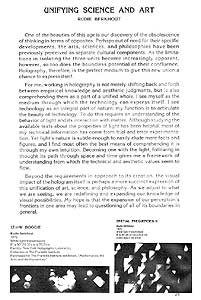
2020 commentary by Al Razutis:
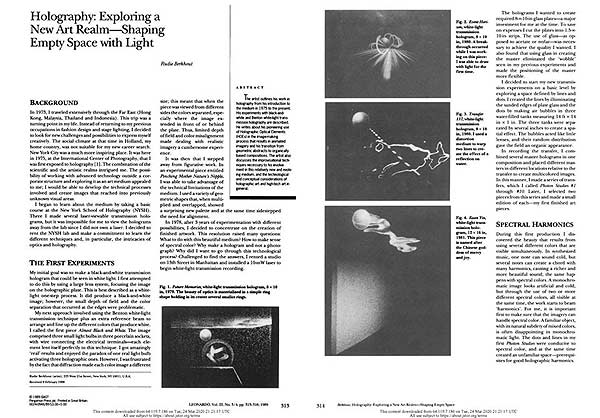
PFD copy (expandable) of this essay can be downloaded at http://www.alchemists.com/fb/leonardo_rudie_1989.pdf
3.4.4 'Some Notes on the Art of Holography' - Al Razutis

PFD copy (expandable) of this essay can be downloaded at http://www.alchemists.com/visual_alchemy/smca/franklin-essay-al.pdf
"Sometimes 'a picture is worth a thousand words', or at least a 3D video of the works that were presented at the Franklin 1979 exhibition "New Spaces". In Razutis' case the works were 'updated' or changed after that show, here is a video in 3D of this.
https://www.youtube.com/watch?v=6D4NwMsgaoQ
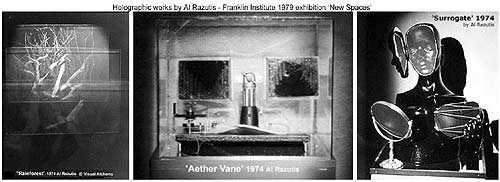
Left to right, 3 holographic works by Al Razutis - 'Rainforest', 'Aether Vane', and 'Surrogate',
Franklin Institute 'New Spaces' exhibition. Click to enlarge in color in separate window.
"
The combination of the surreal and the real creates a dialogue about what is 'real', how images occupy memory, how solid and immaterial exchange places. The framed, installed, sculpted results of these 'hybrids' is one of the early accomplishments of a new art medium like holography asserting its place beyond its predecessor art forms - beyond, but not disconnected.
"
-- AR, 2005


'well, that was the line from a patron, but you get the drift." (AR)
3.4.5 'Integral Holography: The Motion of Circular Space' - Amy Greenfield
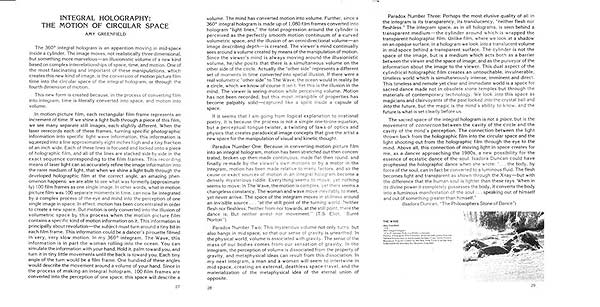
PFD copy (expandable) of this essay can be downloaded at http://www.alchemists.com/visual_alchemy/smca/franklin-essay-amy.pdf
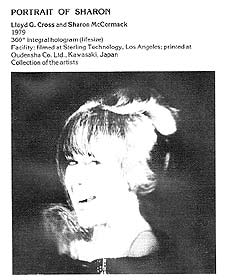
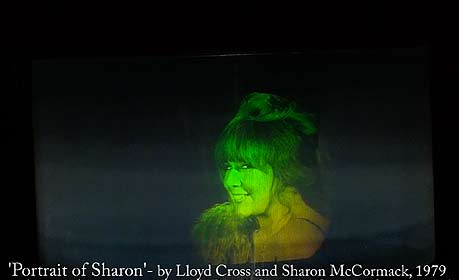


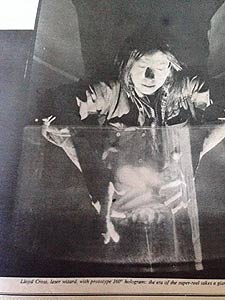
3.5.0 Conclusions on 'Holographic Art'

-- Al Razutis, 2020
3.5.1 'Art discovers Holography and vice versa'


3.5.2 'Let's see what we can do with holography, then call it art'
Lloyd Cross - physicist, Allyn Lite - artist, Jerry Pethick - artist.
3.5.3 Establishing genres of art holography - Two Women Artists Discover Holography.

"I use holography as another medium. I'm not a holographer. I'm an artist. I use
holography. It takes me places. It's a vehicle." -- Anait Arutunoff Stephens
3.5.4 'Abstraction, Minimalism, and Transcendental Art Practice'

Holography: Exploring a New Art Realm: Shaping Empty Space with Light (Leonardo 1989) PDF
Using HOEs in the Holographic Image Making Process
3.5.5 'Neither 3D nor a complete movie, the case of the multiplex hologram, but is it art'
https://youtu.be/7iw4UJ0jjC4
and featuring the multiplex portrait shown in 1979 Franklin Institute exhibition.






3.5.6 'Do We Have An Art Yet?' - Al Razutis
-- Allison C. Meier May 7, 2019
'The Rise and Fall of Hologram Art' at https://daily.jstor.org/the-rise-and-fall-of-hologram-art/
"
The combination of the surreal and the real creates a dialogue about what is 'real', how images occupy memory, how solid and immaterial exchange places. The framed, installed, sculpted results of these 'hybrids' is one of the early accomplishments of a new art medium like holography asserting its place beyond its predecessor art forms - beyond, but not disconnected.
"
-- AR, 2005

3.5.7 To The Moon and Back -- Where We Have Come In All This



-- 'Holography and the Aesthetics of the "Hyperreal,"', Gregory Moynahan, 2012
I hope this 'Art and Holography' Part 3 has provided you with some insights on how that can be accomplished."
-- Al Razutis 2020
'How Much For That Holo?' by Al Razutis, 2020 / 2021

'What do I think in conclusion?'
is to know where we are headed with this.
'3D or not 3d? Dalinian Stereo and Holographic Space'

Appendix and Notes
* APPENDIX A
Hart Perry - Credit for Dali Cinematography updated'
Sat 4/17/2021 9:01 PM
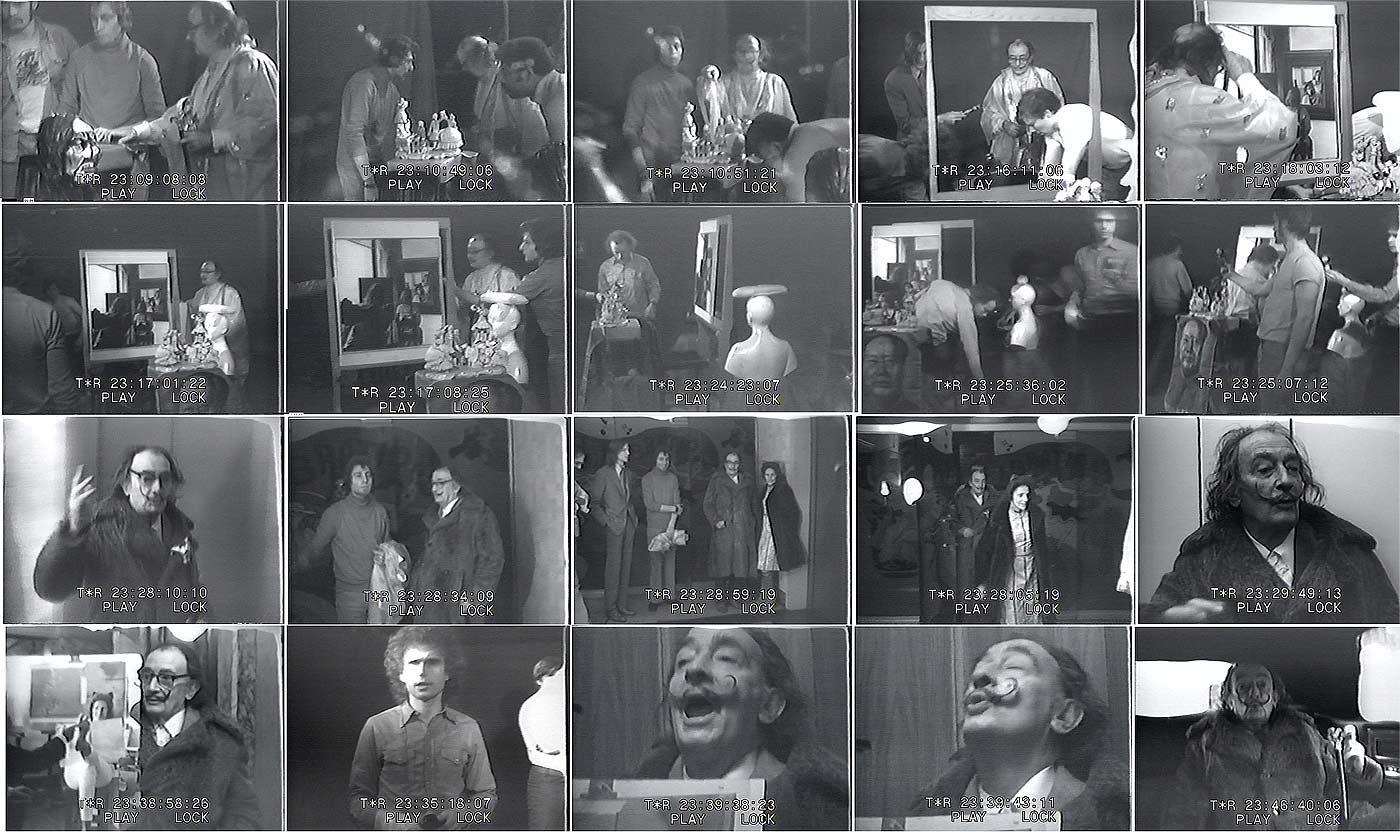
Enlarged picture in separate window
'3D or Not 3D? Dalinian Stereo and Holographic Space' 'The Dali Holograms' (2021)
'How Much for that Holo?' 'Being Dali' (2021)
* APPENDIX B
The Case of Jason Sapan and his 'Invented world'
-- Smithsonian Mag 2018
-- New Yorker 2016
-- Holographic Studios Web Page
"
I think it was back around 1974/75. We were building something, so I had on a lab jacket, a big pair of rubber gloves, and a pair of goggles. The guy I was working with turned to look at me and said, “Ah, it’s Doctor Laser.” It just stuck."
-- Jason Sapan, 6sqft.com interview, 2016

NOTE: the underlined text is emphasis of Sapan's errors of fact and interpretation noted by Al Razutis. Inserted in the below are statements made by Dennis Gabor in his 1971 Nobel Lecture - the full text of which is contained here (as PDF to download).
Jason Sapan begins his recitation:
"The answer to who discovered holography is one of those funny stories... depending on who you ask you're going to get a particular... perspective... Holography is all about perspective. The classic answer that people will say is that it was discovered in the 40's by a scientist named Dennis Gabor... that doesn't mean he actually made holograms (NOTE: that is a patently false statement made by Sapan, what Gabor demonstrated was in-line holography, leading to much more, see below quotes from Gabor's Nobel Prize Lecture)... because he was only talking about a concept... interference of waves..."
MY COMMENT: Sapan doesn't know what he is talking about. Gabor demonstrated 'HOLOGRAPHIC INTERFERENCE', not some simple interference of waves.
-- Dennis Gabor, HOLOGRAPHY, 1948-1971, Nobel Lecture, December 11, 1971, pg. 12
Speaking of the invention of holography and 1947, Dennis Gabor explains:
"The best compromise between coherence
and intensity was offered by the high pressure mercury lamp, which had a
coherence length of only 0.1 mm, enough for about 200 fringes. But in order
to achieve spatial coherence, we (my assistant Ivor Williams and I) had to
illuminate, with one mercury line, a pinhole of 3 microns diameter. This left
us with enough light to make holograms of about 1 cm diameter of objects,
which were microphotographs of about 1 mm diameter, with exposures of a
few minutes, on the most sensitive emulsions then available. The small coherence length forced us to arrange everything in one axis. This is now called
'in line' holography, and it was the only one possible at that time.
"
-- Dennis Gabor, HOLOGRAPHY, 1948-1971, Nobel Lecture, December 11, 1971, pg. 16
" however (in the Nobel web site) he happens to mention someone from the 1890's... (Gabriel Lippman)... so he was the first to do these holographic photographs where you had full color... it was true holographic theory... but he didn't think about using three dimensional objects... but it would have been limited in those days because there wasn't such a thing as a laser... a laser is to light what a tuning fork is to sound... anyway, this guy, his name was Gabriel Lippman... he did win a Nobel Prize for his work (for other discoveries)... that's sort of significant as well... just like Gabor won a prize for his theory... but there was a predecesor..."
"From industrial applications I am now turning to another important development
in holography. In 1962, just before the “holography explosion” the
Soviet physicist Yu. N. Denisyuk published an important paper (13) in which
he combined holography with the ingenious method of photography in natural
colours, for which Gabriel Lippman received the Nobel Prize in 1908. Figure
26 a illustrates Lippmann’s method and Denisyuk’s idea. Lippmann produced
a very fine-grain emulsion, with colloidal silver bromide, and backed the
emulsion with mercury, serving as a mirror."
.... ( .... ) ....
"Though Denisyuk showed considerable experimental skill, lacking a laser in
1962 he could produce only an 'existence proof'. A two-colour reflecting
hologram which could be illuminated with white light was first produced in
1965 by G. W. Stroke and A. Labeyrie"
.... ( .... ) ....
"When the laser became available, in 1962, Leith and Upatnieks could at
once produce results far superior to mine, by a new, simple and very effective
method of eliminating the second image (7). This is the method of the “skew
reference wave”, illustrated in Figure 8. It was made possible by the great
coherence length of the helium-neon laser, which even in 1962 exceeded that
of the mercury lamp by a factor of about 3000" -- Dennis Gabor, HOLOGRAPHY, 1948-1971, Nobel Lecture, December 11, 1971, pgs. 32, 34
MY COMMENT: 'Imagine that! Gabor gives credit to other scientists in his Nobel Prize acceptance speech!' Not like some today in the 'holo scene' spawned since... And that's a story that will be repeated in my posts and web pages.
But Jason Sapan continues to mangle the history of holography, now by bringing up lenticulars, which is a side topic, later leading to 'integrals' and multiplexing images, which is where he has been steering all of this:
"Lippman was also notable for something beyond being the predecessor to holography... he came up with the idea of lenticulars... so the same man came up with the current 3D formats that we look at today... (goes on to talk about Marie Curie, then onto Denysiuk who he says 'made the first actual hologram that we could recognize as a real hologram in the 1950's')..."
More obfuscation, more confusing historical details, and this is what the public gets to hear and read:
(Sapan then wanders on to story of 'Emmet Lieth and his lab assistant Juris Upatnieks') " ... he had another geometry, so they had another architecture than the original Lippman so they were going more toward the Gabor school how you interfere light... and they actually shot the first laser holograms... is that a long enough story for you?"
-- Jason Sapan, Gizmodo, Vimeo -- https://vimeo.com/74477582
COMMENT: "The only thing 'funny' here in this video (seen by thousands, who believed this spiel) is how Sapan tries to make light of that history of which he knows little." (AR)
That bit by Sapan about holography tracing back to Lippman doesn't wash in the history of things. Lippman's 'interference effects' did not correspond to 'holography', but 'color photography'. In fact it is totally dishonest of Sapan to credit Lippman, except perhaps to promote his own fictional 'world view'.
For more reasons refer to Dennis Gabor's 1971 Nobel Lecture accepting the Nobel Prize for Physics for inventing holography to make Gabor's contribution very clear: http://www.alchemists.com/fb/gabor-lecture.pdf
In the world of show business and touting one's shop, all kinds of claims are made to bring those folks in, to do some shopping. So let's not be surprised as unsubstantiated claims spread far and wide on social media by any 'Doctor Laser' who plays at being a neighbourly kind of guy, and an 'expert' on things he knows little of, which makes him in my mind a special kind of fool.
Sapan did not invent any multiplex or 'Integral' (or hologrpahic stereogram) process
First, in the 1970's as he got started he used Multiplex Company services and is listed in their 1970's catalog as 'Sapan Engineering' where people can go to get the movie film (not hologram) 'shot' - the subject on a turntable filmed by motion picture film. As such he developed his business as a 'holographic portrait studio' filming celebrities and later printing multiplex holograms as pictured here. The quality of these works are standard, nothing extraordinary.
This Appendix B, and look at Sapan role as 'doctor laser' concerns not so much 'what is holographic art' but how external influences like Jason Sapan and his operation, published statements, promotions, on-line proclamations affect our notion of 'what is holography', in particular, 'what is a multiplex hologram', or 'holographic stereogram', or 'integral hologram' as Mr. Sapan insists it be called.
This is a useful section to read from the 'Sharon McCormack Collection & Archives' on the birth of multiplex holography and its inventor Lloyd Cross: 'Multiplex Holography' and it comes with many illustrations, documents and videos.
So, what is a multiplex hologram, or an integral as Mr. Sapan calls it?
Click image for enlargement in separate window. Mr. Sapan's text, which he posted on Face Book 'Holography' to shut up his critics reads:
(NOTE: the underlined text is emphasis of Sapan's errors of fact and interpretation noted by Al Razutis)
"Every time any discussion in this group mentions integral holograms, there has been a voice that seeks to discredit them. Certainly everyone has every right to their opinion. However, it gets tiring hearing it repeated as a mantra every time it comes up. As the last professional with a lab still set up to make them, I feel I need to speak up. I make other types of holograms as well, in fact more of those than integral holograms, but they have a special place in my heart. First, it is an integral hologram and not a so called stereogram. That name implies this type of hologram operates through the mistaken idea of stereo pairs. Allow me to explain why this is not the case. If you view this type of hologram you are simultaneously seeing many separate images superimposing together and integrating into one three dimensional holographic image and not just two views. To elaborate further, even if one were to be looking at just two exposures, these two exposures would be non continuous over the period of time during which they were filmed, so the moments in time are not simultaneous, with a typical variant being approximately two and a half seconds depending on the separation of the viewer's eyes.. This means that aside from the rotational difference representing an average of 18 degrees of displacement, the position of the subject in two exposures separated horizontally on the holographic film being viewed may well be totally different during that intervening recording time which would make the superimposition of those two exposures fail to stack in a stereoscopic manner. At best it would result in a distortion known as a time smear where, although the two independently filmed images are fine, the resulting stacking of those images fails to superimpose resulting in a smear. However, a series of images which were recorded fractions of a second apart will integrate into a continuous dimensional matrix stacking neatly on top of each other.
"The name integral comes from its mathematical foundation. In calculus, this image represents the integral of area over time resulting in volume. Secondly, in a hologram, it matters not whether the objects being recorded are two dimensional or three dimensional. The hologram is recording the volume of space in which they exist.
"An artistic hologram which employs flat graphics such as printed words is every bit as much a hologram as one recording an image of a sculpture. To attack the legitimacy of any type of hologram is to attack the medium itself as there are many ways to make many types of holograms. We should not be always fighting. There are more than enough totally fraudulent technologies masquerading as holography. Tearing each other down only serves to weaken us and empowers them. I would hope that with so few of us actually making holograms of all types we could stand together.
" I respect all types of holograms and have made many of them myself. Of course I have my preferences. But far more importantly, I support anyone who is willing to struggle to make a hologram regardless of whether it is technical, artistic, commercial, or just as a hobby. I am not looking to debate the topic of integral holography, but I would hope that when I do choose to make one, I do not have to endure attacks from my own community. I love what I do. I will continue to do it as long as I can with a passion. If there is a type of hologram you love then do that. You have my respect." -- Jason Sapan, Face Book, 'Holography' group, February 9, 2016.
Author (Al Razutis) response in brief:
"Sapan's idea that the multiplex hologram is not a stereogram is unsupportable and incorrect. The discrete views along a horizontal parallax shift offer discrete stereoscopic 3D views of the subject (typically rotating around the vertical axis) and is fused in the mind with 'stereospsis', like in normal perception. Motion of any kind in the multiplex recording is held to a minimum to avoid 'time smearing' effects which degrade the '3D' of the scene when reconstructed. For Mr. Sapan to argue that this recording first on 2D motion-picture film and then printed as a hologram has 'full status' as a holographic recording of amplitude and phase of a scene (the definition of a hologram) is laughable. The lack of vertical parallax, where if you try to see over / under the scene and only get changes in colors whould convince anyone that the multiplex is a quasi-3D display, even if very 'convincing'.
"Sapan invokes his 'calculus' analogy, where the integration (as in integral calculus) is used to calculate a volume when a 'x-y plane' area is rotated along an axis - in this case the vertical y axis. Sapan literalizes this, as if it is the same as the process enjoyed in the production and viewing of a multiplex hologram. Sure go ahead and call it a 'integral hologram', but please Mr. Sapan spare us the false mystification by invoking calculus as if it was an adequate description of the process of making and viewing multiplex holograms.
"And yes, it does matter if the object recorded is 3D or 3D, because if it is 2D we don't need holography, and if it is 3D we record both its amplitude and phase (location in 3D space). The hologram is NOT just "recording the volume of space in which objects exist" - it is recording the object AND the volume of space, meaning the WHOLE scene, and context, and that should be simple and clear. Mr. Sapan's definitions are misleading and ultimately rhetorical, but he has ridden them for years.
"Fans of Sapan's on Face Book gave him 'kudos' for this, a lot of those groups are popularity contests. It is included here to show how the record and history of holography is played with and for whose benefits." (AR)
What do others describe the multiplex hologram as?
For example, what did Amy Greenfield in the 1970's exhibition 'New Spaces, at Franklin Institute described her multiplex or integral holograms as? You can review her essay Integral Holography: The Motion of Circular Space (pdf download), and note the influence of 'filmmakers'(!) let alone the metaphysics of 'turning space into time' or 'time into space' and ending up with a 'volume'...
What do scientitists and inventors call the multiplex hologram? Is it a stereogram, does it work by stereopsis, and what exactly is multiplex anyway? The images below: left, close-ups of multiplex holograms showing vertical stripes, discrete (!) vertical frames, and right a screenshot from Sean Johnston's 'Holographic Visions' on the subject of the development of the multiplex hologram by scientists who considered it a "stereogram".
Yes, all of this matters. It talks about what we are really looking at, rather than imagining, or being told to imagine.
A page dedicated to multiplex holography and the works of Sharon McCormack, Lloyd Cross and others in the field of multiplex holography is in the McCormack Collection and Archives. This collection / archives is administered by Al Razutis, the author of this essay, and contains extensive documentation on the subject of multiplex holograms and their history. Some of this material is present here on this page in Section 3.5.5.
------------- Page Top -------------
* APPENDIX C
The Paper BAG, the Three Michaels and the Harpy
"What goes around, comes around? Not necessarily. Yes Toto, we're in Canada, really!"Now, imagine this!
"Imagine creating a medium, a body of works, a story, then going on voyages, only to return to the place, as if for the first time, and realize the story has been erased. As if to say, it never existed, and there were no voyages, and 'you didn't exist'..." (A.R.)

No, this isn't Homer's Odyssey, the gods are all dead.
No, this isn't by John Lennon, this is life after the party.
"Oh get over it" keeps creeping out like slime from the sidewalks of some New York story. But it was Toronto, they said.
PLAY ONE FOR THE CHEERLEADERS:
"Oh, you can hear the holo-gurls in the wings a-giggling.
They're always looking out for Michael they say,
a giggle, or diffracted moment between them
whichever is near and dear will be the one that remains."
What are we reading here?
This last appendix is a comment on how history is erased, particularly in Canada, and particular to this story of 'Art and Holography', this 'Part 3'.
This story concerns the work and legacy of 'Visual Alchemy', a body of works in holography that was created in the 1970's, toured across Canada and Seattle, USA, and some of which were exhibited internationally in the UK and Europe the the 70's, 80's, 90's, and some of which were placed on view in 2010 in Vancouver at an exhibition of 3D and holography called 'Deja Vu'.
When history is erased, then it is as if "this didn't happen" and "there's no point in talking about it, it's done". Furthermore, "there were no such works of art, no such gallery shows, didn't happen".
And that's what a few individuals in an otherwise international but increasingly insular scene of holographers and artists have been pushing. And that work happened to be mine, by me Al Razutis, the author of this essay, and it's time to respond, not beat around any 'bush of ghosts'.
'Cut away to the voyages of Ulysses, coming back to Ithaca and seeing how it has changed.'
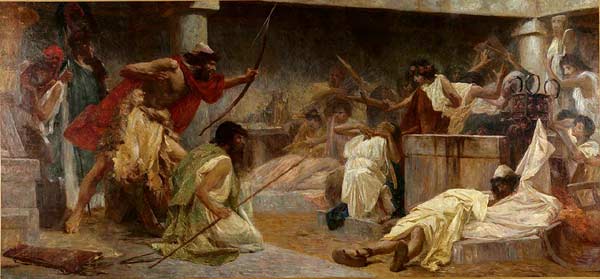
1. Return to Burnaby Art Gallery - sad awakening. Not even a response.
"My visit of March 4, 2018 to Burnaby Art Gallery - as quoted from Face Book
'I paid a visit, I saw and attach a photo of the gallery official history of the 1970's'
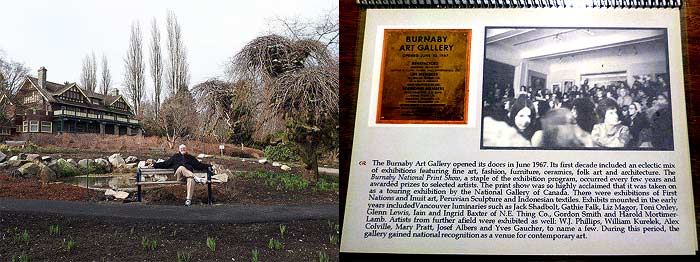
"Last weekend I took a trip to Burnaby Art Gallery to see how it has changed since the 90's when I last visited to retrieve a art piece which they were 'giving back to me', yes, indeed it was being 'returned'...
"The gallery space was smaller than when I had my one-man show "Visual Alchemy" there of holographic art in the 1970's. The staff has changed, the history has changed too. There is NO MENTION of my holographic exhibition 'Visual Alchemy', or the fact that it went on national tour, or that it was opened later that year (1977) in Ottawa during "Canada Day" celebrations by then Prime Minister Pierre Trudeau, or that it changed the course of holographic art history in Canada and internationally.
"Me and my works have been 'written out of the record'
"I conveyed my objections to being written out of the history to the Burnaby Art Gallery folks on their Face Book page and never received a reply." (Al Razutis)
"What was that show exactly that the BAG had erased from its history?"
'Oh that show, that Visual Alchemy by Al Razutis' show which traveled across the country

For more on what was deleted from the BAG and 'the record'
re-visit the above section on 'art of holography' by Razutis 1970's
--------------
"A sneak preview of the conclusion?"
O.k., just once.
Coming across this Michael Snow quote in the Globe and Mail 2012, a publication that keeps touting 'holography' as if it were a projected image of a rocker on stage... here's what Sarah Nicole Prickett ('Special to the Globe and Mail', Aug. 24 2012) wrote in her article. Consider this an 'official Kanadian version of holo history':
"Snow, now 82, seminalized holograms in Canada. My friend Danielle Forest, an art-history grad and project manager at New York's Nyehaus Gallery, wrote her masters thesis on holograms; Snow told her he'd never seen them in an art context before Vancouver's Expo '86, when he was given $800,000 to create a whole holographic world."
-- Sarah Nicole Prickett, Globe and Mail, Aug. 24 2012
https://www.theglobeandmail.com/arts/art-and-architecture/after-the-summer-of-the-hologram-whats-next/article4497013/
That's right kids, you read it right. There was no holography in an 'art context' before there was Expo '86 Vancouver, and Michael Snow, according to Michael Snow. And this is the Great White North, so 'don't argue'.
------------------
2. 'Sorting out the three Michaels'
The Fringe Researh and Interference Gallery archives, the centre of Canadian holographic activities in the 1980's - 1990's were abandoned by the first Michael (Sowden) in Toronto in the early 2000's. He just left town, left the stuff sitting there with no regards for any of this history stuff.
How is that for a 'shock wave'? How's that for 'erasure of history'?
"No big deal" some apologists may have said. "Who cares if the archives of residencies, exhibitions, holograms were abandoned?"
"I think it's a big deal", says the founder of Canadian art holography, Al Razutis, the author here.
Who told me? Why it was the second Michael, Michael Page.
But the first Michael Sowden was a hard-drinking doozy. First, it was "how dare you (Wavefront) critize us!" for the Molteni show at Interference Gallery back in those 1980's.
Then, it was "how dare you criticize Michael Snow", the third Michael, now the first Michael having come into his own, said.
That it was a complete abandonment of the archives, collections, facilities of Fringe Research and Interference Gallery Toronto by Michael Sowdon, who had grown 'fat' with Canada Council grants, then Michael Snow's 800K project for Expo 86, makes it a big deal. Toronto never recovered.
"How dare you!?" is contained in various letters to me and to 'Wavefront' for publishing any such thing as a 'bad revue'... (but make sure you see the footnote below!)
Not a fan of Fred Unterseher and holo-cosmology either? Michael Sowdon had cast his lot with Expo '86.
"Don't criticize Mike Snow" is called "don't bite the hands that feeds" him. Doesn't say much about holo-culture, even if 'Holographics North' actually did the large holo-transfers for the show.
Why is the second Michael (Page) telling me all this, at his place in Toronto in 2005?
"He's setting me up for the next game, the one in which I lose" (AR).
What was this Expo 86 Holo Show Exactly?
The title was 'The Spectral Image', the commission was $800, 000 worth (in 1986 dollars!), the artist was Michael Snow, a guy who had never made a hologram before, and the art director for Expo was Luke Rombout, Director of Vancouver Art Gallery, and a guy who 'hated Al Razutis and his work...'
And who was the technical consultant to the third Michael? Well that was Michael Sowdon who would later leave in a puff of smoke.
Here's some images and reviews. And in the end of this appendix, 'it even gets better!' when in 2012 the Canadian national paper, the Globe and Mail trashes the show...
UNFAVORABLE REVUES, just a sample - underlined by AR:
"The first section in the exhibition was a series of classical white-light transmission holograms entitled Children's Parade, interestingly displayed with plates at different heights and different angles. For the first-time viewer, it was no doubt a baffling experience. Finding a correct viewing angle was a considerable achievement. The title of the series was presumably determined by the subject matter of model cars and helicopters, having been supplied, it appeared, by Woolworths.
"It was not exactly the most encouraging start to a major exhibition. Unfortunately, worse was to follow. A pulsed portrait was built into a door. The image contained a reasonably forgettable number of human heads experiencing a bizarre form of facial ecstasy.
( ... )
"The last section is reserved for pulsed transmission holograms. As a collection, they probably represent the worst holograms ever publicly displayed in recent years.
"Laser transmission holograms are notoriously difficult to illuminate anyway. Maintaining clean optics, constant laser power and perfect laser alignment needs daily if not hourly attention. This obviously was not the case here. Further, the quality of the holograms themselves did nothing to improve an already poor presentation. The subject matter was at least no worse than 95 per cent of all the pulsed holograms produced to date--in other words, boring, unimaginative and the usual waste of everybody's time and money.
"Without any exhibition documents, it was difficult to understand
whether Snow had commissioned all these pieces, or whether individual
artists had pursued their own ideas. Finally, it didn't make much
difference. The artistic input shown here was light years away from the
Berkhouts, the Schweitzers and the Morees of holography The techniques
used were prehistoric compared to the four- and five-color multi image
holograms created by holographers today."
-- Barrie Boulton, Michael Snow's Spectral Image, Wavefront, 1986 (Barrie Boulton is the director of Hologram Europe)
http://www.alchemists.com/visual_alchemy/wavefront/wave12b.html
3. 'Betrayal of the worst kind' -- testimonial by Al Razutis
"Why did Canada fail to establish a permanent home for holography? Why did it fail to create a Museum of the Future?"
"In 2005, I was contacted by Lorraine Monk - the ex-head of the National Film Board (of Canada) Photography Division, the person who had arranged for the Visual Alchemy solo exhibition of my holography in the 1970's to travel to Ottawa, be installed there, to be opened by then Prime Minister Trudeau, and to be seen by hundreds of thousands of people... yes, Lorraine Monk contacted me to come to Toronto and discuss the creation of a Canadian Holography Centre and Museum in conjunction with her project 'Photographers for Peace'.
"Who was going to fund it? Lorraine said it would be the 'Agha Khan', who she had contact with.
"Who was going to design it? It was to be Eberhard Zeidler (Order of Canada Order of Ontario), architect of Vancouver Harbour Canada Place (with distinctive 'sails'), Toronto Eaton Centre, Ontario Place.
"I came to Toronto, we met, we discussed details, strategies, and budgets.
"Curiously enough, a 'group of young videomakers from Ontario College of Art, including the daughter of Michael Page (a Toronto holographer), asked and received permission to 'document some of our discussions' on tape.
"I thought nothing of it at the time.
"We arrived at various agreements, I was all set to produce works for the opening and permanent collections. I've attached some plans so you can see that it was an ambitious project from the get go.
Proposals and drawings by A.R. for Lorraine Monk and 'Canadian Holography Centre and Museum" - click enlarge in separate window

Now it gets better, the plot thickens.
"Prior to my departure back to Vancouver, I spent an evening with Michael Page and Claudette Abrams at their Toronto island residence, looking over the water at downtown Toronto, dining, drinking and having great conversations about holography and the future. They told me how they had 'saved' the hologram masters after Michael Sowden had suddenly packed up his bags and left Fringe Research, Interference Gallery and Toronto for parts unknown. They told me how they had taken these valuable archives, to include my own masters, to the National Archives in Ottawa, and I believed them.
"When I returned home to Vancouver, nothing further happened with this project. Then I received a letter from Lorraine Monk where she said (explicitly) that Michael Page had contacted her privately and 'warned her not to do business with Al' who he described (to her) as a 'fake, and not competent in holography' and 'misrepresenting' what could be done. In other words, he called me a liar, said I was a fraud and couldn't be trusted. This, after all, is a guy who pretended to be my friend the last time I saw him.
"My own published / exhibited works in holography are on the internet and have been there since 1996. http://www.alchemists.com/visual_alchemy/raz-holo.html
"That's right, I was betrayed and defamed behind my back, and presumably this was to destroy the project and my relationship to it. I can't imagine what the reason could be, it was malicious, and nothing ever came out of Toronto holography towards a museum of any kind after this. And after all these years, still nothing has happened. Holography has lost its status at the Canada Council. I haven't been able to get a grant making holograms or writing about them for over twenty years. No Toronto-led project ever surfaced. What was destroyed wouldn't rise from the ashes again because if it could, it would have happened.
"That is Toronto's loss, and Canada's loss. Our country shows itself as parochial, dominated by regionalisms and tribal biases. No one but a few benefitted from inflicting this. Tell me when you get it done." -- Al Razutis, 2020
4. The Defamation Game is played out across decades
"The best version of this game is to 'write someone out of history', but pretend it is otherwise, all hush hush, you think? Make it pleasant. Failing that, make it unpleasant by reversing the blame. 'They are imagining this! (called 'Gaslighting') Even better yet? Pretend it didn't happen! Best version? Which game?
"Way back in the 80's it could have been unpleasant. When Melissa Crenshaw and Walter Clark ('Holographic Studios') decided I had personally 'insulted him' in my residency at their studio by creating a series of 'ugly' holograms with titles such as 'Giving Head To Science and Technology'. It was my ugly period, what can I say. Even my protestations to the contrary didn't convince them that it wasn't about him, but that was the 80's.
Then came the 90's, more games including using my holography proposal to get a Canada Council grant (which she told me she couldn't finish), imagine that, a multiplex rainbox hologram movie project which I had once shown her and which she herself later got after denying me the lab at which point I went to 3D video. She had the nerve to show it to me. The proposal. Who knows what else went down in that holo-gurl sorority heaven.
But this set up, of 'I'm doing a report', 'I need your information' is about as gamy as those 'hologirls' (to include Sally Weber, Melissa's best friend) can get. But not as gamy as Michael Page in Toronto decades earlier who told the client that I was 'unqualified', 'incompetent', and had lied in my proposal to her -- that game brought down the proposed Canadian Museum of Holography. This game is simply Melissa promoting her own cause into the sunset. And pretending otherwise. Who benefits then, when history is lost?
Call this an encounter with 'holo harpies':
It all started with an honest inquiry by me which I will now detail:
Mon, Mar 4, 2019 at 7:20 AM
"Hello Hans,
Can you tell me where I can find conference (the one in Portugal 2018) reports?
I am interested in reading what Melissa Crenshaw included about 'Vancouver' or the 'Canadian scene'. Reason is she asked me for material, then I never heard back as to what was presented. I do not trust her at all, do not work with her in any capacity (same goes for M. Page in Toronto) - it's a bad history, one that will be someday told - and wish to verify (from you) at least that my material was included...
Al Razutis
-----------------
Wed, Mar 6, 2019 at 7:40 AM
"Hi Al, Melissa Crenshaw's conference paper title was: "Construction, Reconstruction and the Travelling Optics Vanity Series." The paper was about her old and recent work in holography. It was nothing about you or anything else in Canada. You can order the proceedings (ISBN 978-972-789-550-2) from Pedro Pombo at the conference website www.isdh20018.pt Hans
------------
Wed, Mar 6, 2019 at 8:06 AM
Well, I don't get it. She contacted me prior to the conference, contacted others, said she was making a presentation about 'holography in Vancouver', wanted updates. So, I sent her my pdf one sheet, and now I read what you just wrote. So if it was her self-promotion, not anything else, it fits the pattern (of Canadian conduct), and the games that have been played up here for decades, and it will be the last time I respond to something like that.
-----------------------------
Then I stopped being polite
After receiving several e-mails from Melissa Crenshaw, first asking for updates, then stating that she had 'only three minutes total for everyone!'... including those who had nothing to update, I decided to stop being polite, and I end it with expletive, which is an appropriate end to this saga called 'Canadian Holography'. (Side note: We can ignore the snickers, the wink wink nudge nudges. 'That' is an eternal affliction for those governed only by 'good etiquette'.)
Sent: Monday, May 28, 2018 12:07 PM
To: Melissa Crenshaw
Subject: Re: ISDH Canada report
" 'Everyone' isn't making holograms nor has made anything for years or decades. Here is your one image as a pdf which is on my web page too. Let the audience look at that for 60 seconds.
" Seeing M. Page or S. Weber on that list of ISDH people makes me want to puke. Page defamed me in an important project in Toronto (a Canadian Holo Centre), Weber published slander in a letter to holo artists (about west coast artists). Fuck them and anyone who hangs with them.
" This is my image, call it a condensed story, direct people to www.alchemists.com which has all the other stories." -- Al Razutis
5. The lasting holo legacy in Canada doesn't even get praise...
Coming across this Michael Snow quote in the Globe and Mail 2012, a publication that keeps touting 'holography' as if it were a projected image of a rocker on stage... here's what Sarah Nicole Prickett ('Special to the Globe and Mail', Aug. 24 2012) wrote in her article. Consider this an 'official Kanadian version of holo history':
"Snow, now 82, seminalized holograms in Canada. My friend Danielle Forest, an art-history grad and project manager at New York's Nyehaus Gallery, wrote her masters thesis on holograms; Snow told her he'd never seen them in an art context before Vancouver's Expo '86, when he was given $800,000 to create a whole holographic world."
This is the lasting legacy of Snow's $800 K Expo '86 show of holograms, the last blast from Canada:
"It was as if, in discovering a magical technique, he felt relieved of having to make anything new. That, or he wanted to turn the realest-seeming objects into holograms, as if to prove that everything we need is illusory. I mean, his '86 exhibit was just anti-fantastic to the point of total banality: tableau after tableau of entirely common, totally correlated objects, with some women thrown in for good measure.
"'If it isn't interesting in real life,' wrote a Vancouver Sun reviewer, 'it isn't interesting as a hologram.'
-- Sarah Nicole Prickett, Globe and Mail, Aug. 24 2012
https://www.theglobeandmail.com/arts/art-and-architecture/after-the-summer-of-the-hologram-whats-next/article4497013/
If not impressed, see Barrie Bolton's revue of this show in 1986
Oh Canada
Is this the legacy for us then? The impersonation of the work of others, the falsifying of the history of things, the writing everyone else out of the history but oneself?. and then resorting to the 'banality of it all?' Oh Canada, 'can you come to terms with thee?'
A Post Script to all this:
The last big show from Canada that 'vanished', but the Canucks don't seem to care!
Lost in Time and Space -- Al Razutis, 1992
Even more relevant is how this ended: 'Holo Vanities' and 'West-Coast Artists in Light' -- 2022 essay by Al Razutis
----------------------------------
------------- Page Top -------------
MORE REFERENCES
TEXTS - PHOTOS: 'Visual Alchemy - Theory / Practice' to include topics on Artaud and Surrealism by Al Razutis.
'Art and Holography' (Part 1, 1985)
'Art and Holography' (Part 2, 1985)
Bride stripped bare: on the problems of interpretation of holographic art (1986)
TEXTS - PHOTOS: '
Holographic Intentions at Visual Alchemy' ("Leaving Plato's Cave with a lot of Baggage")
which is the way it should be.
ILLUSTRATED PAGES - FORMATIVE YEARS in INTERMEDIA 1960'S - 1980'S
For 1963-1965 see 'Psychedelic Cinema ' For 1967 - 1972 see 'Underground - Intermedia'
For 1972 - 1982 see 'Intermedia - Beyond Intermedia', 'Synaesthetic Cinema', 'Holographic Cinema 1970's'
for recent media art studio activities see also 'Projects & Exhibitions'
VISUAL
ALCHEMY & WORKS on FACEBOOK
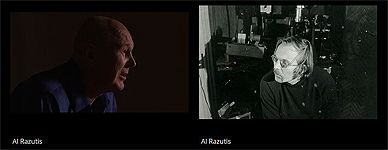
HOME PAGE:
Al
Razutis - Visual Alchemy

